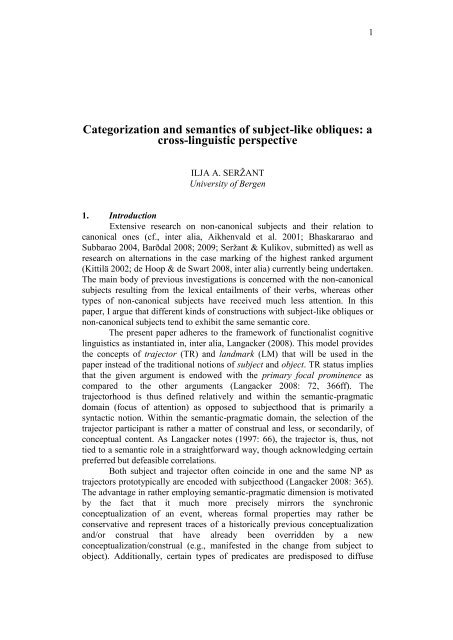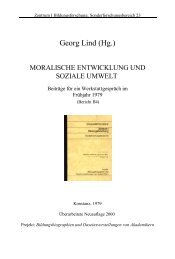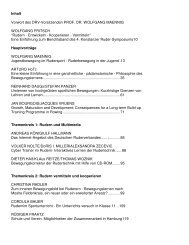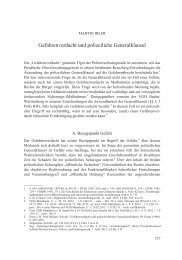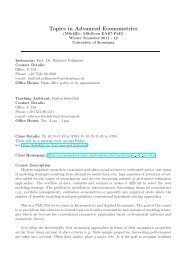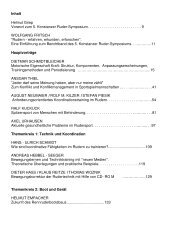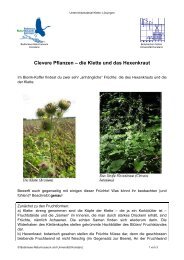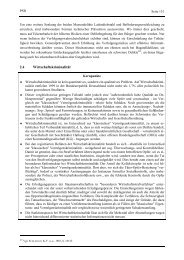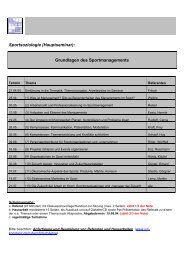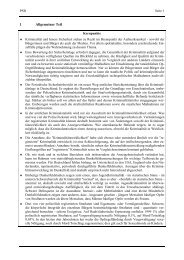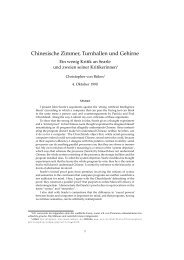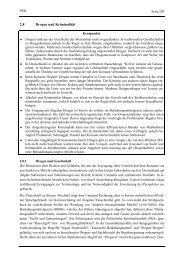Subjects and non-subjects in constructions
Subjects and non-subjects in constructions
Subjects and non-subjects in constructions
You also want an ePaper? Increase the reach of your titles
YUMPU automatically turns print PDFs into web optimized ePapers that Google loves.
1<br />
Categorization <strong>and</strong> semantics of subject-like obliques: a<br />
cross-l<strong>in</strong>guistic perspective<br />
ILJA A. SERŢANT<br />
University of Bergen<br />
1. Introduction<br />
Extensive research on <strong>non</strong>-ca<strong>non</strong>ical <strong>subjects</strong> <strong>and</strong> their relation to<br />
ca<strong>non</strong>ical ones (cf., <strong>in</strong>ter alia, Aikhenvald et al. 2001; Bhaskararao <strong>and</strong><br />
Subbarao 2004, Barðdal 2008; 2009; Serţant & Kulikov, submitted) as well as<br />
research on alternations <strong>in</strong> the case mark<strong>in</strong>g of the highest ranked argument<br />
(Kittilä 2002; de Hoop & de Swart 2008, <strong>in</strong>ter alia) currently be<strong>in</strong>g undertaken.<br />
The ma<strong>in</strong> body of previous <strong>in</strong>vestigations is concerned with the <strong>non</strong>-ca<strong>non</strong>ical<br />
<strong>subjects</strong> result<strong>in</strong>g from the lexical entailments of their verbs, whereas other<br />
types of <strong>non</strong>-ca<strong>non</strong>ical <strong>subjects</strong> have received much less attention. In this<br />
paper, I argue that different k<strong>in</strong>ds of <strong>constructions</strong> with subject-like obliques or<br />
<strong>non</strong>-ca<strong>non</strong>ical <strong>subjects</strong> tend to exhibit the same semantic core.<br />
The present paper adheres to the framework of functionalist cognitive<br />
l<strong>in</strong>guistics as <strong>in</strong>stantiated <strong>in</strong>, <strong>in</strong>ter alia, Langacker (2008). This model provides<br />
the concepts of trajector (TR) <strong>and</strong> l<strong>and</strong>mark (LM) that will be used <strong>in</strong> the<br />
paper <strong>in</strong>stead of the traditional notions of subject <strong>and</strong> object. TR status implies<br />
that the given argument is endowed with the primary focal prom<strong>in</strong>ence as<br />
compared to the other arguments (Langacker 2008: 72, 366ff). The<br />
trajectorhood is thus def<strong>in</strong>ed relatively <strong>and</strong> with<strong>in</strong> the semantic-pragmatic<br />
doma<strong>in</strong> (focus of attention) as opposed to subjecthood that is primarily a<br />
syntactic notion. With<strong>in</strong> the semantic-pragmatic doma<strong>in</strong>, the selection of the<br />
trajector participant is rather a matter of construal <strong>and</strong> less, or secondarily, of<br />
conceptual content. As Langacker notes (1997: 66), the trajector is, thus, not<br />
tied to a semantic role <strong>in</strong> a straightforward way, though acknowledg<strong>in</strong>g certa<strong>in</strong><br />
preferred but defeasible correlations.<br />
Both subject <strong>and</strong> trajector often co<strong>in</strong>cide <strong>in</strong> one <strong>and</strong> the same NP as<br />
trajectors prototypically are encoded with subjecthood (Langacker 2008: 365).<br />
The advantage <strong>in</strong> rather employ<strong>in</strong>g semantic-pragmatic dimension is motivated<br />
by the fact that it much more precisely mirrors the synchronic<br />
conceptualization of an event, whereas formal properties may rather be<br />
conservative <strong>and</strong> represent traces of a historically previous conceptualization<br />
<strong>and</strong>/or construal that have already been overridden by a new<br />
conceptualization/construal (e.g., manifested <strong>in</strong> the change from subject to<br />
object). Additionally, certa<strong>in</strong> types of predicates are predisposed to diffuse
2<br />
subjecthood (cf. Holvoet 2009), i.e. the symmetric predicates <strong>in</strong> Langacker‟s<br />
terms (2008: 369) <strong>and</strong>, as a consequence, apt to some uncerta<strong>in</strong>ty with regard<br />
to trajectorhood. Thus the trajector is subject to prototype effects as regards its<br />
syntactic <strong>and</strong> morphosyntactic encod<strong>in</strong>g: it is the prototypical trajector when it<br />
is encoded by the ca<strong>non</strong>ical subject (i.e. by means of both behavior <strong>and</strong> cod<strong>in</strong>g<br />
properties as def<strong>in</strong>ed <strong>in</strong> Keenan 1976), <strong>and</strong> it is less of a prototypical trajector<br />
when it is only encoded by some of the behavioral <strong>and</strong>/or cod<strong>in</strong>g properties.<br />
This is the type of trajectorhood the present paper is devoted to.<br />
A construction with a trajector argument endowed with only some<br />
subject properties will be referred to here as a <strong>non</strong>-prototypical trajector<br />
construction, abbreviated NTC, while the endowment with morphologically<br />
driven properties (e.g. the nom<strong>in</strong>ative case <strong>and</strong> verbal agreement) alone will<br />
not be taken as <strong>in</strong>dicative of trajectorhood.<br />
I adopt the assumption adhered to by Construction Grammar that<br />
<strong>constructions</strong> are grammatical units which themselves have mean<strong>in</strong>gs<br />
(Goldberg 1995, Croft 2001). Thus the <strong>constructions</strong> under <strong>in</strong>vestigation<br />
encode <strong>non</strong>-prototypical transitivity that is typically substantiated <strong>in</strong> the lack of<br />
full control on the part of the subject-like participant. This mean<strong>in</strong>g is,<br />
however, not marked on the predicate but rather by assign<strong>in</strong>g an oblique case<br />
to its highest ranked argument. Constructions of this type are less frequent <strong>in</strong><br />
accusative languages (Malchukov 2006) but nevertheless can be encountered,<br />
e. g., <strong>in</strong> a number of languages around the Eastern part of the Baltic Sea (East<br />
of Circum-Baltic area as def<strong>in</strong>ed <strong>in</strong> Koptjevskaja-Tamm & Wälchli 2001), cf.<br />
Serţant (2012, forthcom<strong>in</strong>g). Notably, there is great cross- <strong>and</strong> <strong>in</strong>tral<strong>in</strong>guistic<br />
variation as to how languages may syntactically treat this k<strong>in</strong>d of oblique casemarked<br />
argument (Langacker 2008: 359) stretch<strong>in</strong>g from Icel<strong>and</strong>ic with all<br />
subject syntactic properties to English (e.g. <strong>in</strong> it occurs to me that…) with no<br />
subject properties at all. Apart from these two extremes, an <strong>in</strong>termediate stage<br />
seems to be very frequent cross- <strong>and</strong> <strong>in</strong>tral<strong>in</strong>guistically.<br />
The aim of this paper is to provide a categorization of construction<br />
types (Section 2) <strong>and</strong> to approach the core of their mean<strong>in</strong>gs so that the<br />
parallelism <strong>in</strong> their encod<strong>in</strong>g can be expla<strong>in</strong>ed. In Section 3, I will try to<br />
establish the semantics of different k<strong>in</strong>ds of NTCs as well as an <strong>in</strong>variant<br />
semantic core <strong>and</strong> account for the deviations from this core by postulat<strong>in</strong>g a<br />
radial category (cf., <strong>in</strong>ter alia, Lakoff 1987; J<strong>and</strong>a 1993; Luraghi 2009).<br />
2. Categorization of the NTC<br />
The first approach <strong>in</strong> categoriz<strong>in</strong>g different k<strong>in</strong>ds of NTCs is<br />
Haspelmath (2001:56) who suggests the follow<strong>in</strong>g three types thereof: “(i)<br />
reference-related conditions, (ii) clause-related conditions, <strong>and</strong> (iii) predicaterelated<br />
conditions”. In what follows, I will suggest a somewhat modified<br />
categorization.
3<br />
As noted above, the NTCs encode situations or events that considerably<br />
deviate from the transitive prototype (cf., <strong>in</strong>ter alia, Lazard 1998) primarily due<br />
to the lack of proto-agent properties (as <strong>in</strong> Dowty 1991) on the part of the<br />
subject-like argument. The lack of proto-agent entailments can be anchored<br />
differently <strong>in</strong> the event structure. First, it might be due to entailments that the<br />
lexical verb itself imposes on its most salient argument (e.g. an experiencer<br />
verb), i.e. due to the predicate-related conditions <strong>in</strong> Haspelmath (2001:56).<br />
Secondly, different k<strong>in</strong>ds of grammatical categories such as tense, aspect,<br />
mood, negation etc. may override the lexical entailments of the underly<strong>in</strong>g verb<br />
(the clause-related conditions <strong>in</strong> Haspelmath 2001:56). Therefore, John killed<br />
Bill <strong>and</strong> John did not kill Bill considerably differ <strong>in</strong> terms of their proto-agent<br />
<strong>and</strong> proto-patient properties. 1 These differences are <strong>in</strong>duced by the negation<br />
operator <strong>and</strong> do not <strong>in</strong>here <strong>in</strong> the lexical verb kill <strong>in</strong> any straightforward way.<br />
Certa<strong>in</strong> languages adjust the morphosyntactic encod<strong>in</strong>g of the first participant<br />
<strong>in</strong> such cases accord<strong>in</strong>gly. F<strong>in</strong>ally, the clause-external context may also detach<br />
proto-agent properties from a participant. Correspond<strong>in</strong>gly, I will <strong>in</strong>troduce the<br />
follow<strong>in</strong>g categorization of <strong>constructions</strong> with <strong>non</strong>-prototypically encoded<br />
trajectors:<br />
(i) lexeme-driven <strong>non</strong>-prototypical trajector <strong>constructions</strong> (Subsection 2.1),<br />
i.e. those <strong>constructions</strong> <strong>in</strong> which the <strong>non</strong>-ca<strong>non</strong>icity of the first<br />
argument is driven by the lexical entailments;<br />
(ii) gram-driven <strong>non</strong>-prototypical trajector <strong>constructions</strong> (Subsection 2.2),<br />
i.e. those <strong>constructions</strong> <strong>in</strong> which the <strong>non</strong>-ca<strong>non</strong>icity of the first<br />
argument is driven by the correspond<strong>in</strong>g grammatical category <strong>in</strong> that<br />
the verb occurs;<br />
(iii) syntax-driven <strong>non</strong>-prototypical trajector <strong>constructions</strong> (Subsection 2.3),<br />
i.e. those <strong>constructions</strong> <strong>in</strong> which the <strong>non</strong>-ca<strong>non</strong>icity of the first<br />
argument is driven by the clause l<strong>in</strong>k<strong>in</strong>g mechanisms.<br />
This categorization – even if presupposed <strong>in</strong> several previous <strong>in</strong>vestigations –<br />
has not been explicitly formulated except for by Haspelmath (2001). If<br />
speak<strong>in</strong>g formally, one could argue that all three types dist<strong>in</strong>guish which<br />
functional head licenses the oblique case assignment on the first argument.<br />
Needless to say, this categorization rather aims at po<strong>in</strong>t<strong>in</strong>g to the relevant<br />
prototypes, <strong>and</strong> there are obviously predicates where several aspects (i.e. the<br />
syntactic, grammatical <strong>and</strong> lexical fields of the “grammar-lexicon” cont<strong>in</strong>uum)<br />
<strong>in</strong>teract. I will, however, try to avoid the complex types <strong>in</strong> this paper <strong>in</strong> order to<br />
1 E.g., there is no endowment with caus<strong>in</strong>g an event or change of state <strong>in</strong> another participant<br />
(as per Dowty 1991) on the part of the subject argument with the latter; equally, the object<br />
participant is not affected by the event.
4<br />
rema<strong>in</strong> with<strong>in</strong> a certa<strong>in</strong> level of simplicity s<strong>in</strong>ce, first of all, I am try<strong>in</strong>g to<br />
establish the very general semantic motivations which <strong>in</strong> later research may be<br />
applied <strong>and</strong> <strong>in</strong>deed improved by tak<strong>in</strong>g more complex situations <strong>in</strong>to account.<br />
2.1. Lexeme-driven NTCs<br />
A lexeme-driven NTC consists of a lexical predicate that shows up with<br />
<strong>non</strong>-prototypical valence for its most salient argument throughout its paradigm.<br />
The <strong>non</strong>-prototypical morphosyntactic <strong>in</strong>terface is the consequence of the<br />
lexical entailments that this lexical predicate imposes on its argument. This<br />
type of NTC corresponds to the “predicate-related condition” for the <strong>non</strong>ca<strong>non</strong>ical<br />
case assignment <strong>in</strong> Haspelmath (2001). A cross-l<strong>in</strong>guistically<br />
frequent, lexeme-driven NTC is typically an experience denot<strong>in</strong>g predicate, cf.<br />
(1), though not only, cf. (2) <strong>and</strong> (3):<br />
(1) Okku fellur þessi bók (Icel<strong>and</strong>ic)<br />
we.DAT like.3SG this.NOM book.NOM<br />
„We like that.‟<br />
(2) Kalb<strong>in</strong><strong>in</strong>kui trūksta idejų (Lithuanian)<br />
l<strong>in</strong>guist.DAT lack.PRS.3 idea.GEN.PL<br />
„The l<strong>in</strong>guist is short of ideas.‟<br />
(3) Man piestāv šis uzvalks (Latvian)<br />
I.DAT fit:3SG this:NOM suit:NOM<br />
„This suit fits me well.‟<br />
(4) Rebenka vyrvalo kašej (Russian)<br />
child:ACC vomit:PST.3.SG.N porridge:INSTR<br />
„The child vomited the porridge.‟<br />
These lexical verbs subcategorize for <strong>non</strong>-prototypically encoded trajectors<br />
only, at least, <strong>in</strong> relevant mean<strong>in</strong>g; other uses of these verbs are <strong>in</strong>stances of<br />
homonymy <strong>and</strong> never of sy<strong>non</strong>ymy.<br />
As I noted above, trajectorhood is def<strong>in</strong>ed <strong>in</strong> terms of the relative focal<br />
prom<strong>in</strong>ence which is primarily subject to construal. S<strong>in</strong>ce the examples (1)-(4)<br />
all exhibit unmarked word order, I take the <strong>in</strong>itial position of the oblique<br />
argument <strong>in</strong> the unmarked word order as <strong>in</strong>dicative of its primary focal<br />
prom<strong>in</strong>ence <strong>and</strong>, hence, trajectorhood, relative to the second argument <strong>in</strong> these<br />
languages.<br />
Alongside different k<strong>in</strong>ds of experiencer predicates, there are also<br />
beneficiary/maleficiary predicates (such as lack<strong>in</strong>g <strong>and</strong> succeed<strong>in</strong>g <strong>in</strong> ex. 2) or<br />
the mihi-est possessive construction (cf. Clancy 2010 for Slavic).
5<br />
The <strong>non</strong>-prototypical or <strong>non</strong>-ca<strong>non</strong>ical case mark<strong>in</strong>g of the trajector<br />
argument is motivated by its lack<strong>in</strong>g of the most of Proto-Agent properties,<br />
such as volitionality (“volitional <strong>in</strong>volvement <strong>in</strong> the event or state”), causation<br />
(“caus<strong>in</strong>g an event or change of state <strong>in</strong> another participant”) or movement<br />
(“relative to the position of another participant”) <strong>in</strong> terms of Dowty (1991).<br />
2.2. Gram-driven NTCs<br />
Gram-driven NTCs (G-NTC) refer here to those predicates where the<br />
<strong>non</strong>-prototypical case assignment to the trajector argument is not triggered by<br />
the lexical semantics of the given verb (as <strong>in</strong> 2.1 above) <strong>and</strong> not clauseexternally<br />
(as <strong>in</strong> 2.3 below) but rather clause-<strong>in</strong>ternally by the grammatical<br />
category with<strong>in</strong> which it occurs (the clause-related condition <strong>in</strong> Haspelmath<br />
2001:56). That is to say, the case frame <strong>and</strong>, subsequently, the lexical<br />
entailments of the verb are overridden or <strong>in</strong>verted by the entailments of the<br />
grammatical category with<strong>in</strong> which the verb occurs. With lexical NTCs, case is<br />
assigned by the verb on the basis of the argument‟s thematic role, while, with<br />
gram-driven NTCs, the verb‟s case frame is overridden by the imposed case<br />
frame of the given gram (e.g. TAM, negation, quantification etc.). The<br />
grammatical categories that can have such diathetic effects on a lexical verb‟s<br />
case frame are typically the follow<strong>in</strong>g: evidentiality (2.2.1), (deontic) necessity<br />
modality (2.2.2), P-lability anticausative with no morphosyntactic promotion of<br />
the Undergoer argument, perfect/resultative predicates (2.2.3) or negated<br />
genitive subject predicates (2.2.4). 2<br />
2.2.1. Evidentiality<br />
In Lithuanian, the evidential mood can be formed by the <strong>non</strong>-agree<strong>in</strong>g<br />
form of the (formally) passive participle with the genitive case-marked logical<br />
subject <strong>and</strong> nom<strong>in</strong>ative (<strong>and</strong> dialectally accusative) case-marked logical object,<br />
cf. <strong>in</strong>dicative past <strong>in</strong> (5a) <strong>and</strong> the correspond<strong>in</strong>g evidential construction <strong>in</strong> (5b):<br />
(5a) Senieji miškus mylėjo (Lithuanian)<br />
old:NOM.PL forrest:ACC.PL love:PST.3<br />
„The elders loved the forests.‟<br />
(5b) Senų miškai mylė-t-a (Lithuanian)<br />
old:GEN.PL forrest:NOM.PL love-PPP-SG.N<br />
„The elders [apparently] have loved the forests‟ (adopted from<br />
Jablonskis 1922: 141)<br />
2 In this paper, I will not discuss voice, e.g. passive or middle, which also has this function but<br />
usually dooes not result <strong>in</strong> a <strong>non</strong>-ca<strong>non</strong>ical case assignment.
6<br />
The evidential construction has, <strong>in</strong> the past, been regarded by some<br />
scholars as passive (cf., <strong>in</strong>ter alia, Ambrazas et al. 1997). 3 However, apart from<br />
the participle‟s morphology, there is no other reason to regard it as passive:<br />
there is no syntactic, <strong>and</strong> dialectally, no morphological object promotion, 4 nor<br />
is there subject demotion <strong>in</strong> terms of discourse prom<strong>in</strong>ence or word order. The<br />
construction patterns rather with an active construction <strong>in</strong> any other TAM<br />
forms of the given verb. Furthermore, it is usually formed out of <strong>in</strong>transitive<br />
verbs (<strong>in</strong>clud<strong>in</strong>g such unaccusatives as „to be‟) which are highly unlikely to<br />
occur <strong>in</strong> passives as well (Blev<strong>in</strong>s 2003: 495-9; Holvoet 2007: 90ff; Serţant<br />
2012).<br />
The predicate <strong>in</strong> the evidential construction encodes not only two core<br />
participants (the elders <strong>and</strong> the forests as <strong>in</strong> (5b) above), but also an eventexternal<br />
<strong>and</strong> syntactically implicit participant, namely, the “<strong>in</strong>ferer” (which<br />
need not be co-referential with the conceptualizer/speaker). The <strong>in</strong>ferer is<br />
<strong>in</strong>herently present <strong>in</strong> the overall semantic structure <strong>and</strong> cannot be ruled out.<br />
Thus there are two act<strong>in</strong>g or controll<strong>in</strong>g participants <strong>in</strong> the overall semantic<br />
structure of the event encoded by the evidential construction: the event-<strong>in</strong>ternal<br />
participant, the elders, <strong>and</strong> the event-external participant, the <strong>in</strong>ferer. The<br />
<strong>in</strong>ferer consciously makes the <strong>in</strong>ference, (s)he is <strong>in</strong>herently endowed with<br />
sentence <strong>and</strong> perception.<br />
2.2.2. Necessity modals<br />
The Latvian debitive mood is formed by the verbal prefix jā-, dative<br />
case-mark<strong>in</strong>g of the logical subject <strong>and</strong> nom<strong>in</strong>ative case-mark<strong>in</strong>g of the logical<br />
object (colloquially also accusative). The mean<strong>in</strong>g is one of necessity, <strong>in</strong> most<br />
cases deontic necessity, cf. the <strong>in</strong>dicative <strong>in</strong> (6a) <strong>and</strong> debitive <strong>in</strong> (6b):<br />
(6a) Es lasu šo grāmatu (Latvian)<br />
I:NOM read:PRS.1SG this:ACC.SG.F book:ACC.SG.F<br />
„I read/am read<strong>in</strong>g this book.‟<br />
(6b) Man (ir) jā-lasa šī grāmata (Latvian)<br />
I:DAT copula DEB-read.INVAR this:NOM.SG.F book:NOM.SG.F<br />
„I have to read this book.‟<br />
I assume that the reason<strong>in</strong>g here must be parallel to the evidential construction<br />
of Lithuanian. Necessity denotes an obligation subevent that is typically not<br />
under the (full) control of the obligee. In this way, debitive mood also <strong>in</strong>vokes<br />
3 Unfortunately, this view has been reiterated <strong>in</strong> some typological works.<br />
4 Even from a purely morphological perspective, unequivocal object promotion is found <strong>in</strong><br />
Lithuanian only if both the nom<strong>in</strong>ative case-mark<strong>in</strong>g <strong>and</strong> the verbal agreement co-occur. The<br />
nom<strong>in</strong>ative case-mark<strong>in</strong>g alone does not suffice s<strong>in</strong>ce, <strong>in</strong> this language, (<strong>non</strong>-agree<strong>in</strong>g)<br />
nom<strong>in</strong>ative objects <strong>and</strong> nom<strong>in</strong>ative adverbs exist.
7<br />
a second act<strong>in</strong>g participant that is not a core participant of the event „to read<br />
this book‟. It is the “obliger” participant that imposes the obligation on the<br />
agent of the verb lasīt „to read‟ detach<strong>in</strong>g <strong>and</strong> attract<strong>in</strong>g, thereby, Proto-Agent<br />
properties from the agent of the underly<strong>in</strong>g event „read‟. This third participant<br />
can be animate (e.g., a professor that obliged his student to read this book) or<br />
<strong>in</strong>animate circumstances that are not under control of the obligee. The obliger<br />
<strong>and</strong> the very obligation subevent (as with the <strong>in</strong>ferer above) are also <strong>in</strong>herently<br />
covert.<br />
Other predicates express<strong>in</strong>g deontic modality with a <strong>non</strong>-prototypically<br />
marked logical subject can be adduced from Russian (7) (deontic possibility):<br />
(7) Mne ne uvidet‟ Pariža (Russian)<br />
I:DAT not see:INF Paris:GEN<br />
„I will not be able to see Paris‟ [e.g., because I don‟t have enough<br />
money to travel]<br />
In the Russian example, the agent of the subevent embedded under the modal<br />
operator is demoted because most of its controll<strong>in</strong>g properties were overtaken<br />
by the ma<strong>in</strong> participant (e.g. the circumstances that prohibit travel to Paris) of<br />
the implicit “matrix” event.<br />
2.2.3. Resultative/perfect<br />
The North Russian perfect has a fully grammaticalized, valence-bound<br />
<strong>non</strong>-prototypical subject that is marked with the PP u „at‟ + genitive. 5 It fulfils<br />
most of the subject tests such as equi-NP deletion, control of reflexivization<br />
<strong>and</strong> topicality / first position <strong>in</strong> the unmarked word order (Timberlake 1975),<br />
but it cannot trigger verbal agreement, cf. (8):<br />
(8) U menja ruka porane-n-o (North Russian)<br />
at me:GEN h<strong>and</strong>:NOM.SG.F <strong>in</strong>jure:PPP-NOM.N NEUTR.SG=INVAR<br />
„I have <strong>in</strong>jured my h<strong>and</strong>.‟<br />
A resultative or perfect predicate as <strong>in</strong> (8) profiles only the after-state/-situation<br />
subsequent to the event referred to by the lexical verb tak<strong>in</strong>g place (cf. Croft<br />
1998: 56). However, a perfect or resultative predicate is semantically more<br />
complex than a simple stative as <strong>in</strong>, for example, „He is clever‟. The<br />
perfect/resultative predicate profiles an (after-)subevent of the base event,<br />
presuppos<strong>in</strong>g preced<strong>in</strong>g action. Both the preced<strong>in</strong>g action event <strong>and</strong> the<br />
resultative/perfect after-event share the ma<strong>in</strong> participant. Yet, even though the<br />
agent-like ma<strong>in</strong> participant of the preced<strong>in</strong>g action is co-referential with the<br />
patient/experiencer-like ma<strong>in</strong> participant of the resultant after-event, it has<br />
5 There is some subdialectal variation, s. Roduner <strong>and</strong> Privitelli 2006: 417; Serţant 2012.
8<br />
quite different proto-agent entailments <strong>in</strong> Dowty‟s (1991) sense at each of the<br />
stages/profiles. While the agent-like participant of the preced<strong>in</strong>g action is a<br />
prototypical agent that carries out an action, the ma<strong>in</strong> participant of the<br />
resultant after-event is not so. The latter is experienc<strong>in</strong>g a resultant state that<br />
(s)he cannot control (anymore). In the same way, the patient-like participant<br />
cannot affect it either. In other words, the agent-like participant had the<br />
opportunity to control the event at the stage of the preced<strong>in</strong>g action but no<br />
longer has it at the resultant stage (Serţant 2012). The only difference between<br />
this perfect construction, on the one h<strong>and</strong>, <strong>and</strong> the evidential or debitive<br />
construction, on the other h<strong>and</strong>, is that the event-external <strong>and</strong> the event-<strong>in</strong>ternal<br />
ma<strong>in</strong> participants are co-referential. Thus, similarly to the evidential<br />
construction <strong>in</strong> Lithuanian <strong>and</strong> debitive construction <strong>in</strong> Latvian, the North<br />
Russian perfect implies the existence of a third participant that is endowed with<br />
control properties. By compar<strong>in</strong>g the semantics of these different k<strong>in</strong>ds of<br />
gram-driven NTCs, one already gets an idea of what can be semantically<br />
common to all these – at first glance – different <strong>constructions</strong>.<br />
2.2.4. Genitive-under-negation, a special case of G-NTC <strong>in</strong> Russian<br />
Russian has a so-called genitive-under-negation rule entail<strong>in</strong>g that the<br />
objects of transitive predicates <strong>and</strong>, crucially, the <strong>subjects</strong> of some <strong>non</strong>agentive<br />
(unaccusative) <strong>in</strong>transitive predicates may turn from<br />
accusative/nom<strong>in</strong>ative <strong>in</strong>to genitive if the predicate is negated (G-NTC) <strong>and</strong><br />
some additional conditions apply. It has been claimed that reference-related<br />
conditions (cf. Haspelmath 2001:56), such as the referent‟s be<strong>in</strong>g <strong>in</strong> the scope<br />
of the negation, select genitive, cf., <strong>in</strong>ter alia, Babby (2001).<br />
However, this explanation does not account for all cases. It is especially<br />
at odds with those cases, <strong>in</strong> which the genitive case-marked <strong>subjects</strong> are<br />
def<strong>in</strong>ite <strong>and</strong> wide-scope (e.g. with personal pronouns or proper names).<br />
Instead, the rule that accounts for all <strong>in</strong>stances has been put forward <strong>in</strong><br />
Padučeva (1997, 2005). She claims that, under negation, the choice between<br />
nom<strong>in</strong>ative (i.e. the ca<strong>non</strong>ical trajector) <strong>and</strong> genitive (i.e. G-NTC) is governed<br />
by whether or not the absence (negated presence) of the subject NP has been<br />
experienced by an implicit <strong>in</strong>ferer. Contrast the nom<strong>in</strong>ative case-mark<strong>in</strong>g <strong>in</strong><br />
(9a) <strong>and</strong> the genitive case-mark<strong>in</strong>g <strong>in</strong> (9b):<br />
(9a) Otca ne bylo na more (Russian)<br />
father:GEN not be:PST.3.N on see<br />
“Father was not on the seashore” [while I was there <strong>and</strong> I haven‟t seen<br />
him]
9<br />
(9b) Otec ne byl na more (Russian)<br />
father:NOM not be:PST.3.MASC on see<br />
“Father was not on the seashore” [he stayed home]<br />
While (9b) asserts that the father has not been at a certa<strong>in</strong> place/location, the<br />
utterance <strong>in</strong> (9a) implies that the father has not been at a certa<strong>in</strong> place/location<br />
<strong>in</strong> the perceptual world of the <strong>in</strong>ferer (Padučeva 2005: 103). In this example,<br />
the <strong>in</strong>ferer enters the event structure as an implicit additional participant hav<strong>in</strong>g<br />
certa<strong>in</strong> control properties over the overall event alongside the subject<br />
participant, as has been noted by Padučeva (2005). The utterance <strong>in</strong> (17a) not<br />
only implies the absence of the subject referent at the given location<br />
(„seashore‟), but also the presence of the <strong>in</strong>ferer <strong>and</strong> his mental activity. If the<br />
<strong>in</strong>ferer had not been at the location, (s)he would not have been able to make the<br />
<strong>in</strong>ference, part of which is the subject referent („the father‟). In other words, the<br />
very absence of the father at the location can be <strong>in</strong>terpreted as logically<br />
dependent on the implied <strong>in</strong>ference event. Thus Padučeva (2005) states that the<br />
existence at the location is denied <strong>in</strong> the <strong>in</strong>ferer‟s m<strong>in</strong>d when the subject is<br />
case-marked genitive. I also conclude that the genitive-under-negation<br />
<strong>constructions</strong> such as <strong>in</strong> (9b) entail the existence of a ma<strong>in</strong> event, which the<br />
event they encode is logically dependent on.<br />
The controll<strong>in</strong>g properties of the implicit ma<strong>in</strong> event <strong>and</strong> its ma<strong>in</strong><br />
participant may even <strong>in</strong>crease from an <strong>in</strong>ferer to an agent, cf.:<br />
(10) Na šedevrax naročno ne bylo (Russian)<br />
on masterworks on.purpose:ADV not be:PST.SG.N<br />
imen ix sozdatelej,<br />
name:GEN.PL their authors<br />
no vse znali, čto sredi eksponatov -<br />
but all knew, that among showpieces -<br />
Džakometti, Xerst i Kuns<br />
Giacometti, Hirst <strong>and</strong> Koons<br />
„[It was] on purpose [that] there were no author names on the<br />
masterworks; but everyone knew that there were Giacometti, Hirst <strong>and</strong><br />
Koons among the showpieces.‟ (from<br />
www.izvestia.ru/chronicle/article3120761/)<br />
In contrast to Polish (cf. Dziwirek 1994: 173-4, Blaszczak 2008: 125-34),<br />
Russian marg<strong>in</strong>ally allows negated, genitive-subject sentences with agentive<br />
adverbials such as naročno „on purpose‟ <strong>in</strong>dicative of the presence of a<br />
controll<strong>in</strong>g agent, as <strong>in</strong> (10). Crucially, the agentivity properties of the adverb
10<br />
cannot be attributed to the genitive subject referent s<strong>in</strong>ce the latter <strong>in</strong>herently<br />
lacks them <strong>in</strong> this construction. The grammaticality of the sentence <strong>in</strong> (10)<br />
highlights an event structure that, <strong>in</strong> addition to the absence event encoded<br />
overtly, imply presence of an another, implicit event with an implicit<br />
participant. It is this implicit participant that can be attributed the agentivity<br />
properties of the adverb. That is to say, <strong>in</strong> (10), it was an implicit agent that<br />
arranged the exhibition <strong>in</strong> such a way that there were no author names on the<br />
showpieces. This implicit agent is endowed with the follow<strong>in</strong>g proto-agent<br />
entailments (Dowty 1991: 572): (a) volitional <strong>in</strong>volvement <strong>in</strong> the event or state,<br />
(b) sentience, (c) it causes a situation not to take place, <strong>and</strong> (d) it exists<br />
<strong>in</strong>dependently of the event named by the verb.<br />
To summarize, the third implicit participant of this type of G-NTC<br />
<strong>in</strong>feres or arranges the situation <strong>in</strong> such a way that the event encoded by the<br />
underly<strong>in</strong>g lexical verb (restricted to <strong>in</strong>agentives/unaccusatives) does not take<br />
place.<br />
2.3. Syntax-driven NTC<br />
With syntax-driven NTCs (S-NTC), the oblique-case assignment to the<br />
logical subject is triggered by the syntactic (subord<strong>in</strong>ate) status of its clause.<br />
The syntax-driven NTCs differ from both the lexeme- <strong>and</strong> gram-driven ones<br />
formally, namely, <strong>in</strong> that they do not constitute syntactically <strong>in</strong>dependent<br />
(ma<strong>in</strong>) clauses themselves. Nevertheless, these <strong>constructions</strong> also employ the<br />
morphological demotion strategy on the part of their most salient participant<br />
(trajector). I will discuss only some subtypes of syntax-driven NTCs: AcI<br />
(accusativus cum <strong>in</strong>f<strong>in</strong>itivo) (2.3.1) <strong>and</strong> some absolutive <strong>constructions</strong> (2.3.2).<br />
2.3.1. Accusativus cum <strong>in</strong>f<strong>in</strong>itivo (AcI)<br />
Syntax-driven NTCs are well known, for example, from the rais<strong>in</strong>g-toobject-<br />
or control-<strong>constructions</strong> such as <strong>in</strong> English I see him go<strong>in</strong>g <strong>in</strong> which the<br />
subject of the subclause him is encoded with an oblique, typically direct-object<br />
case. Below, I discuss a subtype of subclauses traditionally referred to as<br />
accusativus cum <strong>in</strong>f<strong>in</strong>itivo (AcI), cf. (11) with the ma<strong>in</strong> clause légetai „it is<br />
said‟ <strong>and</strong> the AcI …aphikésthai tòn stratón [lit.] „the army to have come‟:<br />
(11) (Classical Greek)<br />
Es mèn dḕ toûton tòn chôron - légetai-<br />
apikésthai<br />
<strong>in</strong> PRT PRT this the place say:PASS.PRS.3SG arrive:AOR.INF<br />
tòn stratón<br />
the:ACC army:ACC<br />
[lit.] „Until this place, it is said, the army came.‟ (Hdt. 3.26.8)
11<br />
The logical subject tòn stratón, „the army‟, is marked with the accusative case.<br />
Apart from the formal subord<strong>in</strong>ation of this type of NTCs, there is also a<br />
logical dependence <strong>in</strong> terms of semantics: the encoded event is <strong>in</strong>terpreted as<br />
be<strong>in</strong>g <strong>in</strong> the scope of the matrix event. Thus the accusative case-marked logical<br />
subject („army‟) <strong>in</strong> (11) <strong>and</strong> its event encoded by the <strong>in</strong>f<strong>in</strong>itival predicate („to<br />
have arrived‟) are construed as be<strong>in</strong>g dependent on the ma<strong>in</strong> clause event („it is<br />
said‟) with a generic, <strong>in</strong>def<strong>in</strong>ite ma<strong>in</strong> participant. The whole event of arrival is<br />
asserted for the world that is spoken about <strong>in</strong> this sentence <strong>and</strong> that need not be<br />
the same as the real world. Differently from the G-NTCs, with S-NTCs the<br />
logically ma<strong>in</strong> event is overtly expressed („it is said‟) while the event encoded<br />
by the S-NTC is syntactically dependent on it.<br />
The embeddedness of S-NTCs, however, does not always have to be <strong>in</strong><br />
terms of logic; it may also shift <strong>in</strong>to the doma<strong>in</strong> of pragmatics as <strong>in</strong> (12) below.<br />
2.3.2. Absolutive/Adverbial clauses<br />
There are different k<strong>in</strong>ds of absolutive/adverbial <strong>constructions</strong> that<br />
<strong>in</strong>volve different cases, e.g., <strong>in</strong> the ancient Indo-European languages, such as<br />
ablativus absolutus <strong>in</strong> Lat<strong>in</strong>, genitivus absolutus <strong>in</strong> Classical Greek or locativus<br />
absolutus <strong>in</strong> Sanskrit (cf. Keydana 1997). This type of construction also<br />
requires a morphosyntactic “subject-demotion”, cf. the genitivus absolutus<br />
<strong>constructions</strong><strong>in</strong> <strong>in</strong> Ancient Greek:<br />
(12) (Ancient Greek)<br />
Élpeto gàr katà thymòn apostrépsontas hetaírous<br />
hope:3.SG PRT at spirit turn.back:PRTC.ACC.PL fiend:ACC.PL<br />
ek Trṓōn iénai,<br />
from Trojans go:INF<br />
pál<strong>in</strong> Héktoros otrúnantos<br />
back:ADV Hector:GEN.SG stir.up:PRTC.GEN.SG<br />
„For <strong>in</strong> his heart he hoped that friends were com<strong>in</strong>g from the Trojans to<br />
turn [him] back, [s<strong>in</strong>ce] Hector ordered [him] back.‟ (Il. 10.356)<br />
The absolutive adverbial clauses – different to the dependent <strong>constructions</strong> like<br />
AcI – are logically <strong>in</strong>dependent from the situation coded by the respective ma<strong>in</strong><br />
clause, cf. the Lithuanian dative abolutive construction:<br />
(13) (Lithuanian)<br />
Jam atėjus pas karalių, šis paklausė<br />
he:DAT come:PST.CONV to k<strong>in</strong>g this:NOM ask:PST.3<br />
„When he came to the k<strong>in</strong>g, the [k<strong>in</strong>g] asked …‟
12<br />
Logically, the embedded event, „When he came to the k<strong>in</strong>g‟, <strong>in</strong> (13) is not <strong>in</strong><br />
the scope of the ma<strong>in</strong> event. It is presupposed as it does not turn <strong>in</strong>to <strong>non</strong>existence<br />
if the whole sentence is negated. As Cristofaro (2003: 30) po<strong>in</strong>ts out,<br />
one has to dist<strong>in</strong>guish between two dimensions: (i) logical semantics that has to<br />
do with the truth conditions of a sentence <strong>and</strong> (ii) the pragmatic dimension.<br />
“The pragmatic sense … crucially refers to the speakers‟ assumption<br />
concern<strong>in</strong>g the <strong>in</strong>formation status of the sentences they utter” (Cristofaro 2003:<br />
30). Thus the profiles of the subord<strong>in</strong>ate events „he came to the k<strong>in</strong>g‟ (<strong>in</strong> 13)<br />
<strong>and</strong> „Hector ordered him back‟ (<strong>in</strong> 12) are overridden by the profiles of the<br />
respective ma<strong>in</strong> events (<strong>in</strong> terms of Langacker 1987: ch. 7). Notably, the<br />
utterances <strong>in</strong> (12) <strong>and</strong> (13) are about the ma<strong>in</strong> events while the respective<br />
embedded events are neither topics nor foci; they are not construed as onstage<br />
events. The profile of (13) is one of an act of ask<strong>in</strong>g, not com<strong>in</strong>g. While the<br />
ma<strong>in</strong> clauses‟s event has an autonomous profile, the embedded event lacks its<br />
own profile be<strong>in</strong>g a part of the ask<strong>in</strong>g event (cf. Langacker 1991: 498-501;<br />
Cristofaro 2003: 30). It is <strong>in</strong>tended to provide (<strong>in</strong> Langacker‟s terms) a piece of<br />
offstage <strong>in</strong>formation. Furthermore, it is not pragmatically assertive, which can<br />
be tested by sentential questions <strong>and</strong> negations (cf. Cristofaro 2003: 30-3).<br />
Thus, while <strong>in</strong> (11) there is a logical asymmetry <strong>in</strong> terms of scope, <strong>in</strong> (12) <strong>and</strong><br />
(13) there is an asymmetry <strong>in</strong> terms of the construal.<br />
To summarize, the event encoded by S-NTCs entails its dependence on<br />
the matrix event, either <strong>in</strong> terms of semantics or <strong>in</strong>formation structure. In other<br />
words, both the semantically <strong>non</strong>-prototypical trajectors (cf. ex. 11) <strong>and</strong> the<br />
pragmatically <strong>non</strong>-prototypical trajectors (exs. 12 <strong>and</strong> 13) are coded with an<br />
oblique case. Crucially, both these subtypes of S-NTCs entail the existence of<br />
another, prototypical, ma<strong>in</strong> trajector <strong>and</strong> its event (the ma<strong>in</strong> event).<br />
3. A unified semantic account of the <strong>non</strong>-prototypically realized<br />
trajector<br />
In the previous sections I have presented different types of NTCs. Some<br />
similarities across the three types of NTCs have already been <strong>in</strong>dicated. In this<br />
section, an attempt will be made to provide a systematic account of the<br />
denotational facet of NTCs. This account will consist of (i) an <strong>in</strong>variant<br />
semantic core that can be <strong>in</strong>ferred <strong>in</strong> many different types of NTCs <strong>and</strong> (ii)<br />
those denotational aspects that are subject to variation. I adhere to the<br />
constructionist approach to grammar (as substantiated <strong>in</strong>, <strong>in</strong>ter alia, Goldberg<br />
1995, Croft 2001) <strong>and</strong> claim that there is an <strong>in</strong>variant mean<strong>in</strong>g found with<br />
various NTCs. I will start with tak<strong>in</strong>g a closer look at gram-driven NTCs that<br />
are, <strong>in</strong> a way, <strong>in</strong> an <strong>in</strong>termediate position between syntax- <strong>and</strong> lexeme-driven<br />
NTCs.<br />
The conceptual semantics of events encoded by the grammatical<br />
categories such as evidentiality, necessity modality or perfect is complex. Even<br />
though one clause typically refers to only one event, the semantics of gram-
13<br />
driven NTCs implies an additional (ground<strong>in</strong>g) event parallel to the ma<strong>in</strong> event<br />
referred to by the lexical verb. One can describe this implicit event as the<br />
speaker‟s <strong>in</strong>ference-event <strong>in</strong> the case of the evidential construction, or as the<br />
presence of a participant or some event-external circumstances that create an<br />
obligation with the debitive construction, or as the preced<strong>in</strong>g action with the<br />
North Russian perfect construction. In order to demonstrate the common<br />
semantic core, I will compare these <strong>constructions</strong> with causatives.<br />
Generally, a causative predication implies two subevents: an antecedent<br />
subevent <strong>and</strong> the consequent subevent (Nedjalkov & Sil‟nickij 1969).<br />
Accord<strong>in</strong>g to Nedjalkov & Sil‟nickij (1969). There are different k<strong>in</strong>ds of<br />
causatives depend<strong>in</strong>g on the semantic type of the antecedent subevent: from the<br />
permissive causation (cf. 14), i.e. just permitt<strong>in</strong>g the consequent event to come<br />
about, to the coercive causation, i.e. forc<strong>in</strong>g the consequent event to come<br />
about. In the former case, the controll<strong>in</strong>g properties are shared by the trajector<br />
of the antecedent subevent <strong>and</strong> by the trajector of the consequent subevent,<br />
whereas, <strong>in</strong> the latter case, it is rather only the trajector of the antecedent<br />
subevent that is endowed with the control over the whole complex event. Thus,<br />
generally, a whole range of antecedent <strong>and</strong> consequent relations <strong>in</strong> terms of<br />
logical causality is available. Consider an example with permissive causation:<br />
(14) Jean m‟ a laissé partir (French)<br />
John me AUX let:PRTC leave:INF<br />
„John let me leave.‟ [lit. „John admited me to leave‟]<br />
In this example, me (the trajector of the verb partir) is encoded by oblique case<br />
to signal that it has redirected some of its control properties to the causer, i.e. to<br />
Jean: both participants are endowed with control over the subevent encoded by<br />
the lexical verb „to leave‟, both participants are sentient, etc. In other words,<br />
only the cooperation of both participants has allowed the subevent encoded by<br />
„to leave‟ to occur. The ma<strong>in</strong> participant of the matrix event <strong>in</strong>trudes <strong>in</strong>to the<br />
event encoded by the underly<strong>in</strong>g lexical verb <strong>and</strong>, subsequently, reorders the<br />
force-dynamic relations (<strong>in</strong> terms of the causal approach, cf. Talmy 1976,<br />
DeLancey 1985, Langacker 1987, Croft 1993, 1994, 1998a,b). Both subevents<br />
merge, thereby, <strong>in</strong>to one complex event.<br />
Now, turn<strong>in</strong>g back to NTCs, we observe that the only difference<br />
between the causative construction as <strong>in</strong> (14), on the one h<strong>and</strong>, <strong>and</strong> the gramdriven<br />
NTCs (G-NTCs), on the other h<strong>and</strong>, is the presence <strong>in</strong> the former but<br />
absence <strong>in</strong> the latter of an overtly realized ma<strong>in</strong> participant of the antecedent<br />
event. Otherwise, both <strong>constructions</strong> are semantically parallel: both denote a<br />
consequent subevent <strong>and</strong> an implicit antecedent subevent. Thus, as is the case<br />
with the Lithuanian evidential mood, the construction implies an antecedent<br />
event (the <strong>in</strong>ference) <strong>and</strong> a consequent event (the event encoded by the verb).<br />
The same is true for the permissive causation <strong>in</strong> (14) except for the ma<strong>in</strong>
14<br />
participant of the antecedent event. The G-NTCs are construed from the<br />
perspective of the trajector of the consequent event while the permissive<br />
causative <strong>in</strong> (14) is construed from the perspective of the antecedent-event<br />
trajector. Analogically, <strong>in</strong> the case of the Latvian debitive mood, its<br />
construction implies an antecedent event (the obligation) <strong>and</strong> a consequent<br />
event (the event encoded by the verb); other G-NTCs may be analyzed<br />
analogically. One also f<strong>in</strong>ds some sort of cooperation between both trajectors,<br />
the implicit trajector of the antecedent event (the <strong>in</strong>ferer, the obliger) hav<strong>in</strong>g<br />
priority over the overt, <strong>non</strong>-prototypical (consequent-event) trajector (the<br />
<strong>in</strong>feree, the obligee, etc.). This necessarily leads to an oblique case-mark<strong>in</strong>g on<br />
the <strong>in</strong>feree or the obligee, that is, the consequent event trajector. Essentially, G-<br />
NTCs do not provide specific or referential <strong>in</strong>formation about the antecedent<br />
subevent but rather only specify the concept of the antecedent subevent. Thus<br />
the evidential construction implies that the antecedent subevent must be an act<br />
of <strong>in</strong>ference while the necessity modals imply an obligat<strong>in</strong>g subevent (the<br />
existence of obligat<strong>in</strong>g circumstances or persons). However, there is neither<br />
exact identification of nor reference to a particular subevent.<br />
The comparison is particularly obvious <strong>in</strong> those cases where the causee<br />
<strong>and</strong> the obligee are filled with animate NPs. Thus Divjak <strong>and</strong> J<strong>and</strong>a (2008)<br />
argue that the dative arguments with modal predicates <strong>in</strong> Russian are agent<br />
experiencers as they are agents of the embedded event but experiencers of the<br />
modal (antecedent) subevent. Fully parallel to this, the cause of the permissive<br />
causative, as <strong>in</strong> (14), is also a sort of experiencer or beneficiary of the<br />
antecedent admission subevent but (less prototypical) agent of the consequent<br />
(admitted) subevent.<br />
I argue that the <strong>in</strong>ternal structure of G-NTCs consists of two subevents:<br />
an antecedent <strong>and</strong> consequent subevent, somewhat rem<strong>in</strong>iscent of causatives. I<br />
summarize:<br />
G-NTC: The event is construed as an <strong>in</strong>herently consequent subevent:<br />
apart from the onstage <strong>in</strong>formation it entails, it provides <strong>in</strong>formation<br />
about the antecedent subevent with a controll<strong>in</strong>g participant; the<br />
antecedent subevent is described only <strong>in</strong> terms of a concept; the<br />
antecedent subevent <strong>and</strong> its trajector rema<strong>in</strong> <strong>in</strong>herently implicit <strong>and</strong><br />
covert. Semantically, the consequent subevent has <strong>in</strong>herently narrow<br />
scope <strong>in</strong> respect to the antecedent subevent.<br />
Note that the temporal sequence such as, e.g., preced<strong>in</strong>g action vs. resultant<br />
state (as with the North Russian perfect) can also be subsumed under the causal<br />
sequence: obviously, there is also a causal relation between the preced<strong>in</strong>g<br />
action <strong>and</strong> the resultant state: the resultant state can only take place if there has<br />
been a preced<strong>in</strong>g action.
15<br />
As I mentioned above, the antecedent subevent with its ma<strong>in</strong>,<br />
controll<strong>in</strong>g participant is <strong>in</strong>herently covert <strong>and</strong>, hence, <strong>in</strong>herently discursively<br />
backgrounded. It “is quite schematic semantically” <strong>and</strong> “lacks the specificity<br />
<strong>and</strong> rich detail” (<strong>in</strong> terms of Langacker 1990: 13). Nevertheless, the mean<strong>in</strong>g of<br />
the gram determ<strong>in</strong>es the concept of the antecedent subevent which, therefore, is<br />
not arbitrary. The antecedent subevent is a ground<strong>in</strong>g element that <strong>in</strong>heres <strong>in</strong><br />
the verbal morphology <strong>and</strong> <strong>non</strong>-prototypical case assignment to the trajectorlike<br />
argument; it is construed with maximal subjectivity (as def<strong>in</strong>ed <strong>in</strong><br />
Langacker 1985; 1990: 13; 1997; 2008: 259ff).<br />
This is only somewhat different with syntax-driven NTCs that tend to<br />
express the same semantic structure as G-NTCs. With S-NTCs, the antecedent<br />
subevent <strong>and</strong> its ma<strong>in</strong> participant can <strong>and</strong> must be exactly specified. S-NTCs<br />
require reference to a particular action <strong>and</strong> to a particular, ma<strong>in</strong> controll<strong>in</strong>g<br />
participant, respectively. Thus the antecedent subevent is not only conceptually<br />
(as with the G-NTC), but also referentially determ<strong>in</strong>ed. The antecedent<br />
subevent is construed onstage with the S-NTC while it is construed offstage<br />
with the G-NTC (<strong>in</strong> the sense of Langacker 1990; 2008), but both the S-NTC<br />
<strong>and</strong> G-NTC require it. I summarize:<br />
S-NTC: The event is construed as an <strong>in</strong>herently consequent subevent; it<br />
entails an antecedent subevent with the ma<strong>in</strong> participant; the<br />
antecedent subevent <strong>and</strong> its ma<strong>in</strong> participant must be realized by means<br />
of a matrix clause.<br />
There are some gram-driven NTCs that almost exclusively imply the speaker<br />
(the subject of conceptualization Langacker, passim) as the ma<strong>in</strong> participant of<br />
the antecedent subevent which may be cancelled only by embedd<strong>in</strong>g them <strong>in</strong>to<br />
<strong>in</strong>direct speech. These are ma<strong>in</strong>ly epistemic G-NTCs, such as the evidential<br />
construction <strong>in</strong> Lithuanian. It has to be stressed, however, that the ma<strong>in</strong><br />
controll<strong>in</strong>g participant of the implicit antecedent subevent by no means has to<br />
be coreferential with the subject of conceptualization, it can equally be a third<br />
entity, cf., for example, the Latvian debitive construction. It can have epistemic<br />
mean<strong>in</strong>g <strong>in</strong> which, as I noted, the subject of conceptualization will be the<br />
controll<strong>in</strong>g participant anchored <strong>in</strong> the antecedent subevent, but it can also have<br />
dynamic or deontic necessity mean<strong>in</strong>gs which do not impose such restrictions<br />
on the controll<strong>in</strong>g participant of the antecedent subevent. In other words, the<br />
antecedent subevent provides a ground<strong>in</strong>g situation that may but needs not<br />
co<strong>in</strong>cide with the vantage po<strong>in</strong>t (as def<strong>in</strong>ed by Langacker 2008) or with the<br />
subject of conceptualization.<br />
The difference <strong>in</strong> construals between the G- <strong>and</strong> S-NTCs lies <strong>in</strong> how<br />
much <strong>in</strong>formation about the antecedent subevent is provided <strong>and</strong> how this<br />
<strong>in</strong>formation is <strong>in</strong>tegrated <strong>in</strong>to discourse. As I noted, while G-NTCs imply the<br />
existence of the logically antecedent subevent <strong>and</strong> provide its concept only, the
S-NTCs presuppose an explicit reference to a particular antecedent subevent.<br />
The latter is <strong>in</strong>herently backgrounded with the G-NTCs <strong>and</strong> foregrounded with<br />
the S-NTCs.<br />
Now, bear<strong>in</strong>g <strong>in</strong> m<strong>in</strong>d that the conceptual prototype beh<strong>in</strong>d S- <strong>and</strong> G-<br />
NTCs is their logical consequence or “logical embeddedness”, we may now<br />
turn to lexeme-driven NTCs. I assume that generally the same concept is found<br />
with L-NTCs, too: the event is generally conceptualized as be<strong>in</strong>g not controlled<br />
by its ma<strong>in</strong> participant. Recall that, with S-NTCs, the antecedent subevent with<br />
the controll<strong>in</strong>g participant/trajector is onstage, referential, explicit <strong>and</strong><br />
discursively prom<strong>in</strong>ent <strong>and</strong>, with G-NTCs, is offstage, <strong>non</strong>-referential, implicit<br />
<strong>and</strong> discursively <strong>in</strong>herently backgrounded. Yet, with the lexeme-driven NTC<br />
(L-NTC), it is only the existence of an antecedent subevent <strong>and</strong> of an eventexternal<br />
controll<strong>in</strong>g participant that is implied. Thus there is not even<br />
commitment as to what k<strong>in</strong>d of concept the antecedent subevent may belong to.<br />
The L-NTCs encode the very fact that there is someth<strong>in</strong>g or that someth<strong>in</strong>g has<br />
occurred result<strong>in</strong>g <strong>in</strong> the event-<strong>in</strong>ternal ma<strong>in</strong> participant (e.g. the experiencer)<br />
not hav<strong>in</strong>g full control over the situation. Thus, as regards example (1) „We like<br />
this book‟ above, for example, the antecedent subevent may describe some<br />
properties of the book that are responsible for the consequent event, e.g.: This<br />
book is so <strong>in</strong>terest<strong>in</strong>g (<strong>and</strong> so we like it). The concept of the antecedent<br />
subevent is <strong>in</strong> no way pre-determ<strong>in</strong>ed with the L-NTCs <strong>and</strong> is compatible with<br />
any k<strong>in</strong>d of situation that is pragmatically coherent. By imply<strong>in</strong>g that<br />
someth<strong>in</strong>g has occurred to X over which X did not have a full control, one<br />
automatically implies that there was a Y that has been (co-)responsible for<br />
what has occurred to X. It is natural that we sometimes cannot p<strong>in</strong>po<strong>in</strong>t Y, <strong>and</strong><br />
its conceptual content may rema<strong>in</strong> unknown to us <strong>and</strong>/or discursively<br />
irrelevant. The encod<strong>in</strong>g of an event as a logically consequent event allows for<br />
the signall<strong>in</strong>g of the existence of such a Y with no requirement to specify it<br />
somehow. In some languages (as Icel<strong>and</strong>ic, West- <strong>and</strong> East Slavic, Baltic,<br />
F<strong>in</strong>nic, Old Sc<strong>and</strong><strong>in</strong>avian etc.), this strategy to conceptualize the experiencer<br />
events is productive <strong>and</strong> became the ma<strong>in</strong> means of encod<strong>in</strong>g the experiencer<br />
events, whereas <strong>in</strong> other languages, the Transitive Construction is used <strong>in</strong>stead,<br />
which differs regard<strong>in</strong>g its conceptualization.<br />
Indeed, a whole body of empirical evidence exsists for the fact that L-<br />
NTCs may conceptually be related to “weak” causative events like permissive<br />
causativity. Thus both the caused subevent (e.g. <strong>in</strong> 14) <strong>and</strong> the experiencer<br />
event are sometimes encoded by morphologically <strong>in</strong>variant or defective<br />
predicates. One f<strong>in</strong>ds a number of experiencer predicates that consist of an<br />
adverb <strong>and</strong> a light verb, or of a verb <strong>in</strong> the susta<strong>in</strong>ed third person s<strong>in</strong>gular form.<br />
Analogically, the consequent subevents of the causatives are typically encoded<br />
by <strong>in</strong>f<strong>in</strong>itives or participial forms.<br />
Furthermore, many languages encode the causee of a causative<br />
construction <strong>and</strong> the experiencer of some L-NTCs alike. A piece of evidence<br />
16
17<br />
comes from the Mehweb dialect of the East Caucasian language, Dargwa<br />
(Magometov 1982; Ganenkov, forthc.). In this dialect, the subject/experiencer<br />
mark<strong>in</strong>g of the verbs „to f<strong>in</strong>d‟, „to forget‟, „to see‟, „to hear‟, „to know‟, <strong>and</strong> „to<br />
underst<strong>and</strong>‟ changed from the orig<strong>in</strong>al dative common <strong>in</strong> the East Caucasian<br />
languages to encode experiencers, to a locative form (denot<strong>in</strong>g movement <strong>in</strong>to<br />
a mass or attachment to a l<strong>and</strong>mark), cf. the follow<strong>in</strong>g examples (Magometov<br />
1982: 80-81):<br />
(15) di-ze ʜu ǧ-ub-ra. (Dargwa)<br />
I-IN you:SG(ABS) see:PF-PST-1<br />
„I saw you.‟<br />
(16) di-ze b-arg-i-ra kung. (Dargwa)<br />
I-IN N-f<strong>in</strong>d:PF-PST-1 book(ABS)<br />
„I‟ve found a book.‟<br />
Ganenkov (forthc.) argues that the experiencer mark<strong>in</strong>g here is based on the<br />
case-mark<strong>in</strong>g used to encode the causee <strong>in</strong> causative <strong>constructions</strong>, as <strong>in</strong> (17)<br />
from (Magometov 1982: 108):<br />
(17) nu-ni b-ic-aq-i-ra ixi-ze urči. (Dargwa)<br />
I-ERG N-sell:PF-CAUS-PST-1 3SG-IN horse(ABS)<br />
„I made him sell the horse.‟<br />
In this dialect we thus observe an analogical spread of the case-mark<strong>in</strong>g from<br />
the causee (over the <strong>in</strong>voluntary agents) to the experiencers (Ganenkov et al.<br />
2008; Ganenkov, forthc.). This morphosyntactic process calls for explanation,<br />
<strong>and</strong> such an explanation may <strong>in</strong>deed assume that there is a semantic l<strong>in</strong>k<br />
between the conceptualization of the caused/consequent subevent <strong>and</strong> the<br />
experiencer event, <strong>and</strong> eventually between the causee <strong>and</strong> the experiencer.<br />
In the same ve<strong>in</strong> as the examples from Dargwa above, there are some<br />
languages that signal the l<strong>in</strong>k between causatives <strong>and</strong> L-NTCs not by means of<br />
case-mark<strong>in</strong>g but by verb morphology as <strong>in</strong> some Lithuanian or F<strong>in</strong>nic L-NTCs<br />
(cf. Pörn 2008 for an overview on F<strong>in</strong>nish):<br />
(18) Akvilij-ą pyk-<strong>in</strong>-o dėl tokikozės (Lithuanian)<br />
Akvilija feel.nauseous-CAUS-PST.3 due toxicosis<br />
„Akvilija feels nauseous due to toxicosis.‟<br />
(19) M<strong>in</strong>dei säreidii-ta-b (Veps)<br />
I:PART cold-CAUS-PRS.3SG<br />
‘I feel cold.’ (adapted from Zaitseva 2001: 81)
18<br />
(20) (F<strong>in</strong>nish)<br />
M<strong>in</strong>ua pelotti ja ol<strong>in</strong> aivan paniikissa.<br />
I:PART get.scared-CAUS-PST.3SG <strong>and</strong> be:PST.1SG fully <strong>in</strong> panic<br />
‘I got scared <strong>and</strong> was fully <strong>in</strong> panic.’ 6<br />
Notably, also with<strong>in</strong> the formal approach, it has been suggested that such<br />
examples can be treated as causative events without an external argument, the<br />
<strong>in</strong>stigator (Pylkkänen 1999), i.e., <strong>in</strong> our terms, assum<strong>in</strong>g an antecedent<br />
subevent but without nam<strong>in</strong>g it.<br />
I summarize:<br />
L-NTC: The event is conceptualized as an <strong>in</strong>herently consequent event:<br />
it implies the existence of an antecedent event but makes no<br />
assumptions as to the concept of that antecedent event <strong>and</strong>,<br />
consequently, its trajector.<br />
I repeat here the semantic def<strong>in</strong>ition of the G-NTC <strong>and</strong> S-NTC for convenience<br />
<strong>and</strong> comparison:<br />
G-NTC: The event is construed as an <strong>in</strong>herently consequent subevent:<br />
apart from the onstage <strong>in</strong>formation, it entails <strong>and</strong> provides <strong>in</strong>formation<br />
about the antecedent subevent with a controll<strong>in</strong>g participant; the<br />
antecedent subevent is described only <strong>in</strong> terms of a concept; the<br />
antecedent subevent <strong>and</strong> its trajector rema<strong>in</strong> <strong>in</strong>herently implicit <strong>and</strong><br />
covert. Semantically, the consequent subevent has <strong>in</strong>herently narrow<br />
scope <strong>in</strong> respect to the antecedent subevent.<br />
S-NTC: The event is construed as an <strong>in</strong>herently consequent subevent; it<br />
entails an antecedent subevent with the ma<strong>in</strong> participant; the<br />
antecedent subevent <strong>and</strong> its ma<strong>in</strong> participant must be realized by means<br />
of a matrix clause <strong>and</strong> be referential.<br />
S<strong>in</strong>ce it is the conceptualization of an event as a consequent one (i.e. the<br />
implication of an antecedent event) that unites the three NTC types, I will refer<br />
to the NTC as the Consequence Construction, i.e. a construction that encodes<br />
logical embeddedness/consequence of an event. I adhere, thereby, to the view<br />
put forward <strong>in</strong> the framework of the Construction Grammar that <strong>constructions</strong><br />
6 http://www.freewebs.com/one-life/tar<strong>in</strong>at/yks<strong>in</strong>.htm.
19<br />
are mean<strong>in</strong>g-bear<strong>in</strong>g units of grammar (as per, Goldberg 1995, Croft 2001).<br />
Notably, this assumption of the core mean<strong>in</strong>g does not, of course, exclude<br />
different constructional subtypes each with different nuances exist<strong>in</strong>g.<br />
The assumed embeddedness/consequence conceptualization that is<br />
common to all three NTC types accounts for the similarity <strong>in</strong> the ma<strong>in</strong><br />
argument‟s morphological encod<strong>in</strong>g. Additionally, it also accounts for several<br />
other common formal properties, strengthen<strong>in</strong>g the suggested analysis. Thus<br />
different k<strong>in</strong>ds of the Consequence-Construction predicates are typically, <strong>in</strong><br />
some respect, defective with regard to their TAM forms, pattern<strong>in</strong>g somewhat<br />
with the deranked (cf. Stassen 1985; Koptjevskaja-Tamm 1993; Cristofaro<br />
2003; Croft 2001) or <strong>non</strong>-f<strong>in</strong>ite subord<strong>in</strong>ate clauses. Thus, apart from S-NTCs<br />
that are evidently defective crossl<strong>in</strong>guistically (cf., <strong>in</strong>ter alia, Croft 2001: 321;<br />
Evans 2007), G-NTCs <strong>and</strong> L-NTCs also show certa<strong>in</strong> degree of defectiveness:<br />
the Lithuanian evidential <strong>and</strong> the North Russian perfect construction do not<br />
form the future tense, the Lithuanian evidential construction cannot form the<br />
simple past, the Russian <strong>in</strong>dependent-<strong>in</strong>f<strong>in</strong>itive-predicate almost does not<br />
<strong>in</strong>flect for tense (no future, rarely past) <strong>and</strong> mood. Common to all three types is<br />
a certa<strong>in</strong> degree of <strong>non</strong>-f<strong>in</strong>iteness: all gram-driven NTCs mentioned above do<br />
not <strong>in</strong>flect for person <strong>and</strong> are not capable of hav<strong>in</strong>g person agreement.<br />
Additionally, most of them are <strong>in</strong>capable of hav<strong>in</strong>g any k<strong>in</strong>d of agreement,<br />
<strong>in</strong>clud<strong>in</strong>g most of the lexeme-driven NTCs. An exception is only found <strong>in</strong><br />
several lexeme-driven NTCs which may have gender <strong>and</strong> number agreement<br />
with the less subject-like nom<strong>in</strong>ative (only). Though, even these often do not<br />
<strong>in</strong>flect for person (consistently exhibit<strong>in</strong>g third person only), e.g. Icel<strong>and</strong>ic lika<br />
„to like‟.<br />
The connclusions drawn so far can be summarized as follows: all<br />
subtypes of the Consequence Construction discussed here encode the follow<strong>in</strong>g<br />
conceptualization, <strong>and</strong> many of them have the follow<strong>in</strong>g morphosyntactic<br />
properties:<br />
Conceptualization<br />
Morphosyntactic<br />
properties<br />
the event is conceptualized as a consequent<br />
(conceptually embedded) event<br />
- defectiveness as regards TAM;<br />
- lack of person-number forms or generally:<br />
- <strong>in</strong>f<strong>in</strong>ite<br />
Table 1: Conceptualization <strong>and</strong> morfosyntactic properties of the Consequence<br />
Construction.<br />
The three types of NTCs are differentiated, however, by how much <strong>in</strong>formation<br />
on the antecedent event they entail <strong>and</strong> by the discursive prom<strong>in</strong>ence thereof.
20<br />
Thus the antecedent event has the follow<strong>in</strong>g properties encoded with each type<br />
of NTC:<br />
Properties of the Syntax-driven Gram-driven Lexeme-driven<br />
Antecedent event: NTC<br />
NTC<br />
NTC<br />
Concept a particular concept of the<br />
antecedent event is implied<br />
no commitment as<br />
to a particular<br />
concept<br />
Doma<strong>in</strong> superclausal<br />
doma<strong>in</strong><br />
clausal<br />
doma<strong>in</strong><br />
lexeme<br />
doma<strong>in</strong><br />
Explicitness explicit implicit - 7<br />
Def<strong>in</strong>iteness def<strong>in</strong>ite, generic, <strong>non</strong>referr<strong>in</strong>g<br />
-<br />
referr<strong>in</strong>g<br />
Discourse fore-grounded back-grounded -<br />
Table 2: Properties of the Antecedent event.<br />
As a prelim<strong>in</strong>ary result, I suggest that the hypocategories of the Consequence<br />
Construction discussed here have an <strong>in</strong>variant semantic core (cf. table 1) which<br />
implies the existence of another, logically antecedent event anchor<strong>in</strong>g yet<br />
another, ma<strong>in</strong> participant external to the event encoded by the Consequence<br />
Construction. Note that the antecedent event here is taken very broadly to also<br />
<strong>in</strong>clude the concept of stative situations such as, for example, the existence of<br />
an external controll<strong>in</strong>g participant that is <strong>in</strong> some way responsible for what the<br />
event encoded by the Consequency Construction denotes. While the entailment<br />
of an antecedent event is the common semantic core of all NTCs, deviations<br />
from this core are conf<strong>in</strong>ed to how much <strong>in</strong>formation about the antecedent<br />
event they provide <strong>and</strong> the discursive status of this <strong>in</strong>formation, see table 1<br />
above.<br />
A variation like this, which exhibits an <strong>in</strong>variant semantic <strong>and</strong> formal<br />
core while hav<strong>in</strong>g a number of vary<strong>in</strong>g parameters, can be captured by<br />
postulat<strong>in</strong>g a radial category (Lakoff 1987; J<strong>and</strong>a 1993; Luraghi 2009). Radial<br />
categories presuppose a central, prototype category that is responsible for<br />
l<strong>in</strong>k<strong>in</strong>g the network of its partial deviations. The l<strong>in</strong>k<strong>in</strong>g rules represent the<br />
semantic proximity between the prototype <strong>and</strong> its quasi-sy<strong>non</strong>yms as well as<br />
mirror the semantic relationship with regard to other quasi-sy<strong>non</strong>yms, thereby<br />
provid<strong>in</strong>g the <strong>in</strong>ternal structure of the overall category (J<strong>and</strong>a 1993). As Nesset<br />
et al. (2011) note, there is no uniqueness requirement, that is to say, a particular<br />
radial subcategory of a category may enter radial relationship with several<br />
prototypes at the same time.<br />
7 ”-“ means not applicable.
21<br />
Orig<strong>in</strong>ally, prototype categories have only been applied to lexical<br />
concepts (extend<strong>in</strong>g beyond the pure l<strong>in</strong>guistic dimension, cf. Hudson 1980).<br />
Subsequently, the prototype category has also been applied to l<strong>in</strong>guistic units at<br />
the grammatical edge of the language realm, cf. Bybee <strong>and</strong> Moder (1983),<br />
Taylor (1995). In this paper, I will apply the notion of the prototype <strong>and</strong> the<br />
radial category approach to illustrate the correlation of both semantics <strong>and</strong><br />
formal expression, i.e., the more distant a category is compared to the<br />
prototype, the less overlap it shows <strong>in</strong> both its formal organization <strong>and</strong><br />
semantics.<br />
Figure 1 represents the semantico-syntactic organization of different<br />
extensions of the Consequence Construction <strong>in</strong> terms of a radial category:<br />
Figure 1: Consequence Construction as a Radial Category.<br />
(prototypes are squares; their radial subcategories are round)<br />
As noted <strong>in</strong> Nesset et al. (2011), subcategories may have several<br />
prototypes (as <strong>in</strong>dicated <strong>in</strong> Figure 1). This is the case with both G-NTCs <strong>and</strong><br />
L-NTCs. I assume that several particular G-NTCs <strong>and</strong> L-NTCs are<br />
conceptually l<strong>in</strong>ked to the transitive-construction prototype as def<strong>in</strong>ed <strong>in</strong><br />
Lazard (1998), as well (this is rendered by the arrow <strong>in</strong> Figure 1). With<strong>in</strong> this<br />
conceptualization, the less salient participant metaphorically acts on the more
22<br />
salient one, cf. English This made me angry. Here, This encodes an <strong>in</strong>animate<br />
stimulus <strong>and</strong> me an animate experiencer. This construal implies that the<br />
transmission of the force dynamics runs from the stimulus This to the<br />
experiencer me (cf. Talmy 1988; Croft 1998: 55; Croft 1994). Obviously, this<br />
use is a metaphorical extension of the transitive construction <strong>in</strong> English.<br />
However, such metaphorical extensions can approach the Consequence<br />
Construction with its properties <strong>in</strong> diachronic perspective. Thus cf. (18) from<br />
German that patterns <strong>in</strong> very much the same way as the English example above<br />
but, <strong>in</strong> contrast, exhibits some deviations towards Consequence Construction:<br />
(18) Mich ergriff die Angst (German)<br />
I:ACC grasp:PST.3.SG the fear:NOM<br />
„I got scared.‟<br />
Evidently, (18) also represents a metaphorical extension of the transitive<br />
construction. However, the unmarked word order, <strong>in</strong> contrast to the English<br />
example, is reversed. In (18), it is rather the accusative-case-marked argument<br />
that is the trajector <strong>and</strong> the nom<strong>in</strong>ative-case-marked argument that is the<br />
l<strong>and</strong>mark (<strong>in</strong> terms of Langacker 1987: 217ff. <strong>and</strong> 2008: 70ff.). By virtue of the<br />
word order, the construal of example (18) approaches the consequence<br />
construction <strong>and</strong> diverges from its orig<strong>in</strong>al transitive construction.<br />
There are some other differences that group L-NTCs <strong>and</strong> G-NTCs<br />
together. The G-NTCs <strong>and</strong> L-NTCs types of the consequency construction<br />
<strong>in</strong>stantiate <strong>in</strong>dependent, ma<strong>in</strong> clauses, whereas the consequence construciton of<br />
the S-NTC type always constitutes a syntactically dependent, subord<strong>in</strong>ate<br />
clause. The syntactic status of a clause, <strong>in</strong> turn, imposes certa<strong>in</strong> requirements<br />
on its <strong>in</strong>ternal morphosyntactic organization. It has often been noticed that<br />
ma<strong>in</strong> clauses lack<strong>in</strong>g a nom<strong>in</strong>ative subject are generally dispreferred (<strong>in</strong><br />
accusative languages), cf. Tsunoda‟s Unmarked-Case-Constra<strong>in</strong>t which<br />
predicts that, <strong>in</strong> a <strong>non</strong>-elliptical sentence, at least one NP must be <strong>in</strong> the<br />
unmarked case, i.e. nom<strong>in</strong>ative or absolutive, (Tsunoda 1981), “Obligatory<br />
NOM Requirement” <strong>in</strong> Primus (1999), “Default L<strong>in</strong>k<strong>in</strong>g” <strong>in</strong> Wunderlich &<br />
Lakämper (2001), Malchukov (2005: 95). At the same time, there is no such<br />
restriction for the <strong>in</strong>f<strong>in</strong>ite subclauses, which typically lack nom<strong>in</strong>ative. Thus<br />
the L-NTCs <strong>and</strong> G-NTCs also deviate from the S-NTCs <strong>in</strong> terms of their<br />
<strong>in</strong>ternal morphosyntactic organization.<br />
4. Some diachronic evidence (<strong>in</strong>subord<strong>in</strong>ation)<br />
In this Section, I will provide some diachronic evidence for the unified<br />
semantic analysis of all three types of the NTCs suggested above. I have<br />
suggested above that all three types of NTCs are construed as consequent<br />
events, the difference between them be<strong>in</strong>g <strong>in</strong> how the antecedent event is<br />
construed <strong>and</strong> realized. I will show that diachronic developments from the S-
23<br />
NTC to the G-NTC confirm this analysis s<strong>in</strong>ce the changes, which take place <strong>in</strong><br />
these developments, are changes <strong>in</strong> the construal <strong>and</strong> realization of the<br />
antecedent event only while the consequent event rema<strong>in</strong>s persistent<br />
throughout the development. Consider (9) repeated as (19) for convenience:<br />
(19) (Classical Greek)<br />
Es mèn dḕ toûton tòn chôron - légetai-<br />
apikésthai<br />
<strong>in</strong> PRT PRT this the place say:PASS.PRS.3SG arrive:AOR.INF<br />
tòn stratón<br />
the:ACC army:ACC<br />
[lit.] „Until this place, people say, the army came.‟ (Hdt. 3.26.8)<br />
The construction <strong>in</strong> (19) represents a <strong>non</strong>-grammaticalized evidential mean<strong>in</strong>g<br />
<strong>in</strong>duced by the matrix verb légetai „it is be<strong>in</strong>g said‟. However, the embedded S-<br />
NTC does have the potential to shift from a S-NTC <strong>in</strong>to a G-NTC, cf. (20):<br />
(20) (Classical Greek)<br />
toútous dè éphasan oikeîn anà tà órē ...<br />
these:ACC.PL PRT say:AOR.3PL live:INF on the mounta<strong>in</strong>s<br />
kaì basiléōs ouk akoúe<strong>in</strong><br />
<strong>and</strong> k<strong>in</strong>g:GEN.SG not hear:INF<br />
allà kaì embaleîn pote eis autoùs basilikḗn stratiàn<br />
but <strong>and</strong> <strong>in</strong>vade:INF once <strong>in</strong> they k<strong>in</strong>g‟s:ADJ.ACC.SG<br />
army:ACC.SG<br />
dṓdeka myriádas.<br />
twelve 10- thous<strong>and</strong><br />
toútōn d‟ oudén‟ aponostêsai dià tḕn dyschōrían.<br />
these:GEN.PL PRT <strong>non</strong>e:ACC.SG come.back:INF due the bad.place<br />
„These, - they said, - dwelt up among the mounta<strong>in</strong>s, …, <strong>and</strong> were not<br />
<strong>subjects</strong> of the K<strong>in</strong>g; <strong>in</strong> fact, a royal army of one hundred <strong>and</strong> twenty<br />
thous<strong>and</strong> men had once <strong>in</strong>vaded them, <strong>and</strong>, by reason of the ruggedness<br />
of the country, not a man of all that number came back.’ (X. Anab.<br />
3.5.16 17, translated by Brownson 1922)<br />
The last (sub)clause, oudéna aponostêsai [<strong>non</strong>e:ACC come.back:INF], with the<br />
aorist <strong>in</strong>f<strong>in</strong>itive is already several clauses distant from the matrix predicate<br />
éphasan „they said‟; it also shows a change <strong>in</strong> its subject referent [lit.] „<strong>non</strong>e of
24<br />
the men‟ <strong>in</strong>stead of „these‟ as <strong>in</strong> the <strong>in</strong>f<strong>in</strong>itive clauses before. Note also the<br />
punctuation (that is org<strong>in</strong>al). These <strong>in</strong>dications suggest a certa<strong>in</strong> degree of<br />
emancipation of the AcI construction from its matrix predicate <strong>and</strong> change <strong>in</strong>to<br />
a reportative mood. Even though Greek has not conventionalized <strong>and</strong><br />
grammaticalized this use as a reportative mood, example (20) still shows that<br />
the potential for a full emancipation of the AcI has existed. This is a less<br />
frequently discussed subtype of <strong>in</strong>subord<strong>in</strong>ation, which is a process widely<br />
attested cross-l<strong>in</strong>guistically whereby an orig<strong>in</strong>al subord<strong>in</strong>ate clause is<br />
re<strong>in</strong>terpreted as a ma<strong>in</strong> clause reta<strong>in</strong><strong>in</strong>g <strong>and</strong> conventionaliz<strong>in</strong>g the concept of<br />
the former ma<strong>in</strong> clause (see Evans 2007 for an extensive typological<br />
overview). Such a development is also attested <strong>in</strong> Classical Lat<strong>in</strong> even to a<br />
higher degree. In this language, the AcI can emancipate <strong>and</strong> be used without a<br />
matrix predicate that is then only conceptually (as with the G-NTCs) implied.<br />
As such, the exclamatory use of sīc<strong>in</strong>e „thus (negatively)‟ is often used with the<br />
AcI (Lewis & Short, sub verbo), cf. (21) from Plautus Pers. 45:<br />
(21) sīc<strong>in</strong>e hoc tē mihī facere (Lat<strong>in</strong>)<br />
thus this:ACC(=NOM) you:ACC I:DAT do:INF<br />
„[Ought you] to be treat<strong>in</strong>g me <strong>in</strong> this fashion?‟<br />
In the construction sīc<strong>in</strong>e + AcI, a modal event denot<strong>in</strong>g necessity <strong>in</strong> very<br />
general terms, i.e. only conceptually, is implied. Thus the orig<strong>in</strong>al S-NTC form<br />
becomes a G-NTC here, represent<strong>in</strong>g another <strong>in</strong>stance of <strong>in</strong>subord<strong>in</strong>ation. The<br />
loss of the antecedent clause might be discursively motivated. As Langacker<br />
(2008: 418) po<strong>in</strong>ts out, the real news is often the consequent event while the<br />
antecedent event only <strong>in</strong>troduces <strong>and</strong> frames it.<br />
Crucially, noth<strong>in</strong>g happens to the very consequent event dur<strong>in</strong>g this<br />
change: it rema<strong>in</strong>s the same throughout the development. The changes only<br />
affect the set of <strong>in</strong>formation regard<strong>in</strong>g the antecedent event that must be<br />
m<strong>in</strong>imally present at a particular utterance: orig<strong>in</strong>ally, the antecedent event<br />
must have been specified, but <strong>in</strong> examples such as (21), only its concept is<br />
provided.<br />
5. Conclusions<br />
To summarize the ma<strong>in</strong> conclusions, I have first put forward a<br />
categorization of the NTCs <strong>in</strong>to lexeme-, gram- <strong>and</strong> syntax-driven NTCs<br />
accord<strong>in</strong>g to the source of the entailments on the trajector-like argument that<br />
lead to the assignment of an oblique case to that argument. I emphasize that<br />
this disivion is an approximation gloss<strong>in</strong>g over more specific subtypes (like the<br />
genitive-under-negation construction which respresents a special subtype of G-<br />
NTC comb<strong>in</strong>ed with the type referrd to as “reference-related conditions” <strong>in</strong><br />
Haspelmath 2001:56).
25<br />
Secondly, I have suggested a radial category, which I labelled<br />
Consequence Construction <strong>and</strong> which has an <strong>in</strong>variant semantic core with all<br />
three types of NTCs, namely, the implication of an (logically) antecedent event<br />
anchor<strong>in</strong>g an external participant that (logically) (co-)controls the event carried<br />
out by the ma<strong>in</strong> participant of the event referred to. The difference between the<br />
three different NTC subtypes lies <strong>in</strong> how the antecedent event is construed <strong>and</strong><br />
what k<strong>in</strong>d of <strong>in</strong>formation the given NTC provides <strong>and</strong> requires about it. While<br />
L-NTCs only imply the existence of an antecedent event, mak<strong>in</strong>g no further<br />
commitments, G-NTCs also provide the concept of the antecedent event.<br />
F<strong>in</strong>ally, S-NTCs are even more specific <strong>and</strong> require an exact reference to the<br />
antecedent event <strong>and</strong> its ma<strong>in</strong> participant.<br />
Thirdly, I have tried to provide some diachronic evidence illustrat<strong>in</strong>g<br />
the change from syntax- to gram-driven NTCs, a subtype of the process of<br />
<strong>in</strong>subord<strong>in</strong>ation described <strong>in</strong> Evans (2007). The transition from S-NTC to G-<br />
NTC represents an <strong>in</strong>stance of subjectification (cf., <strong>in</strong>ter alia, Langacker 1990;<br />
Traugot <strong>and</strong> Dasher 2003).<br />
Acknowledgements<br />
Many ideas <strong>in</strong> this paper were <strong>in</strong>spired by the PhD course <strong>in</strong> Cognitive<br />
L<strong>in</strong>guistics at the University of Tromsø, April 26-29, 2011, organized by Laura<br />
J<strong>and</strong>a <strong>and</strong> Tore Nesset. I also thank the editors of the present volume for their<br />
comments. Alls disclaimers apply.<br />
Abbreviations<br />
ABS – absolutive, ACC – accusative, ADJ – adjective, ADV – adverb, AOR –<br />
aorist, AUX – auxiliary, CAUS – causative, DAT – dative, DEB – debitive, ERG –<br />
ergative, F – fem<strong>in</strong><strong>in</strong>e, GEN – genitive, IN – location <strong>in</strong>side a l<strong>and</strong>mark, INF –<br />
<strong>in</strong>f<strong>in</strong>itive, INSTR – <strong>in</strong>strumental, INVAR – <strong>in</strong>variant, MASC – mascul<strong>in</strong>e, N –<br />
neuter, NOM – nom<strong>in</strong>ative, PART – partitive, PASS – passive, PF – perfective<br />
stem, PL – plural, PPP – passive past participle, PRS – present, PRT – particle,<br />
PRTC – participle, PST – past, SG – s<strong>in</strong>gular, TAM – tense-aspect-mood.<br />
PDL: Perseus Digital Library. Gregory R. Crane, Editor-<strong>in</strong>-Chief, Tufts<br />
University. http://www.perseus.tufts.edu/<br />
RNC - Russian National Corpus at http://www.ruscorpora.ru/search-ma<strong>in</strong>.html<br />
REFERENCES<br />
Aikhenvald, A., R. M. W. Dixon, M. Onishi 2001. Non-ca<strong>non</strong>ical mark<strong>in</strong>g of<br />
<strong>Subjects</strong> <strong>and</strong> Objects. Typological Studies <strong>in</strong> Language 46.<br />
Amsterdam/Philadelphia: Benjam<strong>in</strong>s.
Ambrazas et al. 1997: V. Ambrazas, E. Genušienė, A. Girdenis, N. Sliţienė, D.<br />
Tekorienė. Lithuanian Grammar. Lietuvių kalbos gramatika ed. by V.<br />
Ambrazas. Vilnius. Baltos lankos.<br />
Babby, L. H. 2001. “The genitive of negation: a unified analysis”. In Annual<br />
Workshop on Formal Approaches to Slavic L<strong>in</strong>guistics: The Bloom<strong>in</strong>gton<br />
Meet<strong>in</strong>g 2000 (FASL 9), edited by Steven Franks, Tracy Holloway K<strong>in</strong>g<br />
<strong>and</strong> Michael Yadroff, 39-55. Ann Arbor: Michigan Slavic Publications.<br />
Barðdal, J. 2008. Productivity: Evidence from Case <strong>and</strong> Argument Structure <strong>in</strong><br />
Icel<strong>and</strong>ic. Amsterdam: John Benjam<strong>in</strong>s.<br />
Barðdal, J. 2009. The Development of Case <strong>in</strong> Germanic. In The Role of<br />
Semantic, Pragmatic <strong>and</strong> Discourse Factors <strong>in</strong> the Development of Case<br />
ed. by Jóhanna Barðdal & Shobhana Chelliah, 123–159. Amsterdam: John<br />
Benjam<strong>in</strong>s.<br />
Bhaskararao, K. <strong>and</strong> V. Subbarao 2004. Non-nom<strong>in</strong>ative <strong>subjects</strong>, Vol. 1–2.<br />
Amsterdam/Philadelphia: John Benjam<strong>in</strong>s.<br />
Blaszczak, J. 2008. “Differential subject Mark<strong>in</strong>g <strong>in</strong> Polishˮ. In: Differential<br />
subject Mark<strong>in</strong>g ed. by Helen de Hoop & Peter Swart. Studies <strong>in</strong> Natural<br />
Language <strong>and</strong> L<strong>in</strong>guistic Theory 72. Dordrecht: Spr<strong>in</strong>ger Netherl<strong>and</strong>s.<br />
113–150.<br />
Blev<strong>in</strong>s, J. 2003. “Passives <strong>and</strong> Impersonalsˮ. Journal of L<strong>in</strong>guistics 39, 473–<br />
520.<br />
Brownson, C. L. 1922. Xenophon. Xenophon <strong>in</strong> Seven Volumes, 3. Harvard<br />
University Press, Cambridge, MA; William He<strong>in</strong>emann, Ltd., London.<br />
(Quoted from the PDL).<br />
Bybee, J. L. <strong>and</strong> C. L. Moder 1983. “Morphological classes as natural<br />
categoriesˮ. Language 59, 251–270.<br />
Clancy, S. J. 2010. The Cha<strong>in</strong> of Be<strong>in</strong>g <strong>and</strong> Hav<strong>in</strong>g <strong>in</strong> Slavic. SLCS 122.<br />
Amsterdam/Philadelphia: Benjam<strong>in</strong>s.<br />
Cole, P., W. Harbert, G. Hermon & S.N. Sridhar 1980. “The acquisition of<br />
subjecthoodˮ. Language 56, 719–43.<br />
Cristofaro, S. 2003. Subord<strong>in</strong>ation. Oxford studies <strong>in</strong> typology <strong>and</strong> l<strong>in</strong>guistic<br />
theory. Oxford: Oxford University Press<br />
Croft, W. 1993. “The Semantics of Mental Verbsˮ. In: Semantics <strong>and</strong> the<br />
Lexicon ed. by J. Pustejovsky, 55–72. Dordrecht/Boston/London: Kluwer<br />
Academic Publishers.<br />
Croft, W. 1994. “The Semantics of Subjecthoodˮ. In: Subjecthood <strong>and</strong><br />
Subjectivity. M. Yaguello (ed.), The Status of the Subject <strong>in</strong> l<strong>in</strong>guistic<br />
Theory. Proceed<strong>in</strong>gs of the Colloquium “The Status of the Subject <strong>in</strong><br />
L<strong>in</strong>guistic Theory” London, 19-20 March 1993. Paris: OPHRYS, 29–76.<br />
Croft, W. 1998a. “Event Structure <strong>in</strong> Argument L<strong>in</strong>k<strong>in</strong>gˮ. In The Projection of<br />
Arguments. Lexical <strong>and</strong> Compositional Factors ed. by M. Butt & W.<br />
Geuder, 21–64. Stanford. CSLI Publications.<br />
Croft 1998b. “The structure of events <strong>and</strong> the structure of languageˮ. The new<br />
psychology of language: cognitive <strong>and</strong> functional approaches to language<br />
26
structure, ed. Michael Tomasello, 67–92. Mahwah, N.J.: Lawrence<br />
Erlbaum Associates.<br />
Croft, W. 2001. Radical Construction Grammar. Syntactic Theory <strong>in</strong><br />
Typological Perspective. Oxford/New York: Oxford University Press.<br />
DeLancey 1985. “Agentivity <strong>and</strong> syntaxˮ. In Papers from the Parasession on<br />
Causativity <strong>and</strong> Agentivity at the Twenty-First Regional Meet<strong>in</strong>g ed. by<br />
W. H. Eilfort, P. D. Kroeber & K. L. Peterson, 1–12. Chichago L<strong>in</strong>guistic<br />
Society (CLS 21), Part 2. Chicago: Chicago L<strong>in</strong>guistic Society.<br />
Dziwirek, K. 1994. Polish <strong>subjects</strong>. New York/London: Garl<strong>and</strong> Publish<strong>in</strong>g.<br />
Evans, N. 2007. “Insubord<strong>in</strong>ation <strong>and</strong> its uses. Chapter 11”. In F<strong>in</strong>iteness.<br />
Theoretical <strong>and</strong> Empirical Foundations, edited by Ir<strong>in</strong>a Nikolaeva,<br />
Oxford: OUP, 366-432.<br />
Ganenkov, D., T. Maisak & Solmaz R. Merdanova. 2008. “Involuntary Agent<br />
as <strong>non</strong>-ca<strong>non</strong>ical subject <strong>in</strong> Agul”. In: Differential subject mark<strong>in</strong>g, edited<br />
by Helen de Hoop & Peter de Swart, 173-198. Spr<strong>in</strong>ger.<br />
Ganenkov, D. Forthc. “Diachrony of Experiencer Subject Mark<strong>in</strong>g: Evidence<br />
from East Caucasian”. In: The Diachronic Typology of Non-ca<strong>non</strong>ical<br />
<strong>Subjects</strong>, edited by Serţant, I. A. & L. Kulikov. SLCS Series. John<br />
Benjam<strong>in</strong>s.<br />
Goldberg, A. E. 1995. Constructions: A construction grammar approach to<br />
argument structure. Chicago: University of Chicago Press.<br />
Haspelmath, M. 2001. “Non-ca<strong>non</strong>ical mark<strong>in</strong>g of core arguments <strong>in</strong> European<br />
languages”. In: Non-ca<strong>non</strong>ical Mark<strong>in</strong>g of <strong>Subjects</strong> <strong>and</strong> Objects, edited by<br />
Aikhenvald, A., R. M. W. Dixon & M. Onishi, 53-83. Amsterdam: John<br />
Benjam<strong>in</strong>s.<br />
Holvoet, A. 2007. Mood <strong>and</strong> Modality <strong>in</strong> Baltic. Baltica Varsoviensia VI.<br />
Kraków.<br />
Holvoet, A. 2009. “Difuz<strong>in</strong>iai subjektai ir objektaiˮ. In Gramat<strong>in</strong>ių funkcijų<br />
prigimtis ir raiška ed. by A. Holvoet & R. Mikulskas, 37–68. Vilnius:<br />
Vilniaus universitetas & Asociacija „Academia Salensis‟. [Diffused<br />
<strong>subjects</strong> <strong>and</strong> objects]<br />
de Hoop, H. <strong>and</strong> P. Swart 2008. Differential subject Mark<strong>in</strong>g. Studies <strong>in</strong><br />
Natural Language <strong>and</strong> L<strong>in</strong>guistic Theory 72. Dordrecht : Spr<strong>in</strong>ger<br />
Netherl<strong>and</strong>s.<br />
Hudson, R. 1980. Sociol<strong>in</strong>guistics. Cambridge: Cambridge University Press.<br />
Jablonskis, J. 1922. Lietuvių kalbos gramatika. Etimologija. Kaunas, Vilnius.<br />
Švyturio. [Grammar of Lithuanian. Etymology]<br />
J<strong>and</strong>a, L. 1993. A Geography of Case Semantics. The Czech Dative <strong>and</strong> the<br />
Russian Instrumental. Berl<strong>in</strong>: Mouton de Gruyter.<br />
Keenan, E. L. 1976. “Towards a Universal Def<strong>in</strong>ition of „Subject‟. In Subject<br />
<strong>and</strong> Topic ed. by Ch. Li, 303–333. New York: Academic Press.<br />
Keydana, G. 1997. Absolute Konstruktionen <strong>in</strong> alt<strong>in</strong>dogermanischen Sprachen.<br />
Gött<strong>in</strong>gen: V<strong>and</strong>enhoeck & Ruprecht.<br />
27
Kittilä, S. 2002. Transitivity: toward a comprehensive typology. Åbo: Åbo<br />
Akademiska Tryckeri.<br />
Koptjevskaja-Tamm, M. 1993. Nom<strong>in</strong>alizations. London: Routledge.<br />
Lakoff, G. 1987. Women, Fire <strong>and</strong> Dangerous Th<strong>in</strong>gs. Chicago: Chicago<br />
University Press.<br />
Langacker, R. W. 1985. “Observations <strong>and</strong> Speculations on Subjectivityˮ. In<br />
Iconicity <strong>in</strong> Syntax ed. by J. Haiman, 109–150. Amsterdam/Philadelphia:<br />
John Benjam<strong>in</strong>s.<br />
Langacker, R. W. 1990. “Subjectificationˮ. Cognitive L<strong>in</strong>guistics 1, 5–38.<br />
Langacker, R. W. 1997. “Consciousness, Construal <strong>and</strong> Subjectivityˮ. In<br />
Language Structure, Discourse <strong>and</strong> the Access to Consciousness ed. by M.<br />
I. Stamenov, 49–77. Amsterdam/Philadelphia: John Benjam<strong>in</strong>s.<br />
Langacker, R. W. 2006. “Subjectification, grammaticalization, <strong>and</strong> conceptual<br />
archetypesˮ. In Subjectification. Various Paths to Subjectivity ed. by A.<br />
Athanasiadou, C. Canakis & B. Cornille, 17‒40. Berl<strong>in</strong>/New York:<br />
Mouton de Gruyter.<br />
Langacker, R. W. 2008. Cognitive Grammar. A Basic Introduction. New York.<br />
Oxford University Press.<br />
Lazard, G. 1998. “Transitivity Revisited as an Example of a More Strict<br />
Approach <strong>in</strong> Typological Researchˮ. Folia L<strong>in</strong>guistica XXXVI (3-4):<br />
141–90.<br />
Lewis & Short: A Lat<strong>in</strong> dictionary: founded on Andrews' edition of Freund's<br />
Lat<strong>in</strong> dictionary / revised, enlarged <strong>and</strong> <strong>in</strong> great part rewritten by<br />
Charlton T. Lewis <strong>and</strong> Charles Short. First published <strong>in</strong> 1879. [Quoted<br />
from PDL]<br />
Luraghi, S. 2009. “Case <strong>in</strong> Cognitive Grammarˮ. Chapter 9. In The Oxford<br />
H<strong>and</strong>book of Case ed. by A. Malchukov & A. Spencer, 135–150.<br />
Oxford/New York: Oxford University Press.<br />
Magometov, A. A. 1982. Megebskij dialect darg<strong>in</strong>skogo jazyka (issledovanie i<br />
teksty). Tbilisi: Mecniereba.<br />
Malchukov, A. 2005. “Case Pattern Splits, Verb Types <strong>and</strong> Construction<br />
Competitionˮ. In Competition <strong>and</strong> Variation <strong>in</strong> Natural Languages. The<br />
Case for Case ed. by M. Amberber & H. de Hoop, 73–118. Amsterdam-<br />
Boston … Elsvier.<br />
Malchukov, A. 2006. “Transitivity parameters <strong>and</strong> transitivity alternationsˮ. In<br />
Case, Valency <strong>and</strong> Transitivity ed. by L. Kulikov, A. Malchukov & P. de<br />
Swart, 329–58. Amsterdam/Philadelphia. John Benjam<strong>in</strong>s.<br />
Moravcsik, E. A. 1978. “Ergative <strong>and</strong> accusative patternsˮ. L<strong>in</strong>gua 45, 233–<br />
279.<br />
Nedjalkov, V. P. & G. G. Sil‟nickij 1969. Tipologija kauzativnych konstrukcij,<br />
<strong>in</strong>: Xolodovič 1969, 5-20. [Typology of Causative Constructions]<br />
Nesset, T., A. Endresen & L. J<strong>and</strong>a 2011. “Two ways to get out: Radial<br />
Category Profil<strong>in</strong>g <strong>and</strong> the Russian Prefixes vy- <strong>and</strong> iz-”. Zeitschrift für<br />
Slawistik 56(4), 377-402.<br />
28
Padučeva, Je. V. 1997. “Roditel‟nyj subjekta v otricatel‟nom predloţenii:<br />
s<strong>in</strong>taksis ili semantika?ˮ Voprosy Jazykoznanija 2, 101–116. [The genitive<br />
case of subject <strong>in</strong> a negated sentence: syntax or semantics?]<br />
Padučeva, Je. V. 2005. “Eščo raz o genitive subjekta pri otricaniiˮ. Voprosy<br />
Jazykoznanija 2005[5], 84–99. [Once aga<strong>in</strong> about the genitive under<br />
negation]<br />
Partee, B. H. <strong>and</strong> V. Borschev 2004. “The semantics of Russian genitive of<br />
negation: The nature <strong>and</strong> role of perspectival structureˮ. Proceed<strong>in</strong>gs of<br />
SALT 14, Evanston, Ill<strong>in</strong>ois.<br />
Pörn, M. 2008. “Psychophysical <strong>and</strong> Physical Causative Emotion Verbs <strong>in</strong><br />
F<strong>in</strong>nish: The Temporal Structure of Causative Emotion Verb + Inf<strong>in</strong>itive 1<br />
-Constructions with<strong>in</strong> Conceptual Semantics”. SKY Journal of L<strong>in</strong>guistics<br />
21, 201–218.<br />
Primus, B. 1999. Cases <strong>and</strong> thematic roles. Tüb<strong>in</strong>gen. Niemeyer.<br />
Pylkännen, L. 1999. “Causation <strong>and</strong> external arguments”. In: Papers from the<br />
second Penn/MIT roundtable on the lexicon, MIT Work<strong>in</strong>g Papers <strong>in</strong><br />
L<strong>in</strong>guistics 35, edited by Pylkkänen, L., A. van Hout & H. Harley.<br />
Cambridge, MA: MIT161-183<br />
Roduner, M. <strong>and</strong> T. Privitelli 2006. “Der Genitiv des Agens / Experiencers <strong>in</strong><br />
Litauischen und Russischen Dialektenˮ. Acta Balto-Slavica 30, 403–425.<br />
Serţant, I. A. (forthcom<strong>in</strong>g): “Dative experiencer <strong>constructions</strong> as a Circum-<br />
Baltic isoglossˮ. In Contemporary Approaches to Baltic L<strong>in</strong>guistics ed. by<br />
P. Arkadiev, A. Holvoet & B. Wiemer. De Gruyter.<br />
Serţant, I. A. 2012: “The so-called possessive perfect <strong>in</strong> North Russian <strong>and</strong> the<br />
Circum-Baltic area. A diachronic <strong>and</strong> areal approachˮ, L<strong>in</strong>gua 122, 356-<br />
385.<br />
Serţant, I. A. & L. Kulikov (submitted): Diachronic Typology of Nonca<strong>non</strong>ical<br />
<strong>Subjects</strong>, ed. by I. A. Serţant & L. Kulikov.<br />
Amsterdam/Philadelphia: John Benjam<strong>in</strong>s.<br />
Stassen, L. 1985. Comparison <strong>and</strong> Universal Grammar. Oxford: Basil<br />
Blackwell.<br />
Talmy, L. 1976. “Semantic causative typesˮ. The grammar of causative<br />
<strong>constructions</strong>. (Syntax <strong>and</strong> Semantics, Vol. 6.) ed. by Masayoshi<br />
Shibatani, 43–116. New York: Academic Press.<br />
Talmy, L. 1988. “Force dynamics <strong>in</strong> language <strong>and</strong> cognitionˮ. Cognitive<br />
Science 12, 49–100.<br />
Taylor, J. 1995. “Grammatical categoriesˮ, ch. 10. In L<strong>in</strong>guistic<br />
Categorization: Prototypes <strong>in</strong> L<strong>in</strong>guistic Theory. Oxford: Oxford<br />
University Press, 2 nd ed., 293–308.<br />
Timberlake, A. 1975. “Subject properties <strong>in</strong> the North Russian Passiveˮ. In<br />
Subject <strong>and</strong> Topic ed. by Li & Thompson, 545‒594. New York: Academic<br />
Press.<br />
Traugott, E. C. <strong>and</strong> R. B. Dasher 2002. Regularity <strong>in</strong> Semantic Change.<br />
Cambridge: Cambridge University Press.<br />
29
Tsunoda, T. 1981. “Splitcase-mark<strong>in</strong>g <strong>in</strong> verb types <strong>and</strong> tense/aspect/moodˮ.<br />
L<strong>in</strong>guistics 19, 389–438.<br />
Tsunoda, T. 1985. “Remarks on Transitivityˮ. Journal of L<strong>in</strong>guistics 21, 385-<br />
396.<br />
Wunderlich, D. & Lakämper, R. 2001. ˮOn the <strong>in</strong>teration of structural <strong>and</strong><br />
semantic caseˮ. In Effects of morphological case ed. by H. de Hoop, O.<br />
Koeneman, J. Mulders & F. Weerman, 377–417. L<strong>in</strong>gua.<br />
Xolodovič, A. 1969: Tipologija kauzativnych konstrukcij. Morfonologičeskij<br />
kauzativ. Akademija Nauk SSSR, Institut Jazykoznanija. Len<strong>in</strong>grad.<br />
[Typology of the causative <strong>constructions</strong>. The morphonological<br />
causative].<br />
30


